Book Summaries
U.S. History
Regional History
Military History
Statesmen and Authors
Explorers and Inventors
American Indians
American Negros
U. S. History
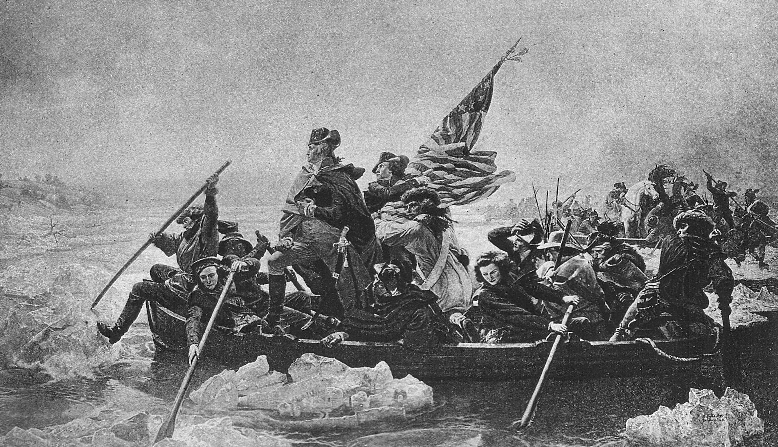
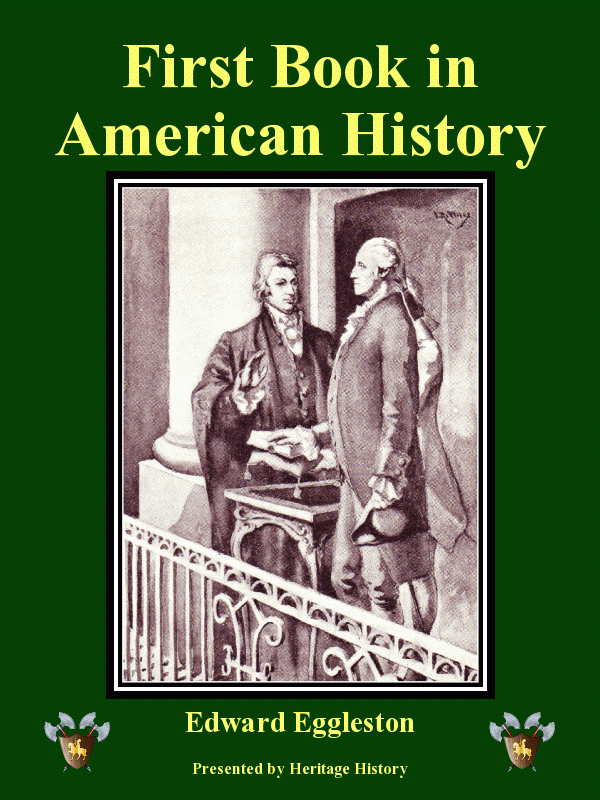 |
First Book in American
History by Edward Eggleston
Edward Eggleston wrote a number of books that include short vignettes of American
history appropriate for younger grammar school children. In this book his stories
are arranged in chronological order and cover most of the major events from the landing of
Columbus to the end of the Civil War. Short stories from American history from the landing
of Columbus to the end of the Civil War. It could be used as an introductory American
history for grammar school students.
[109 sheets]
|
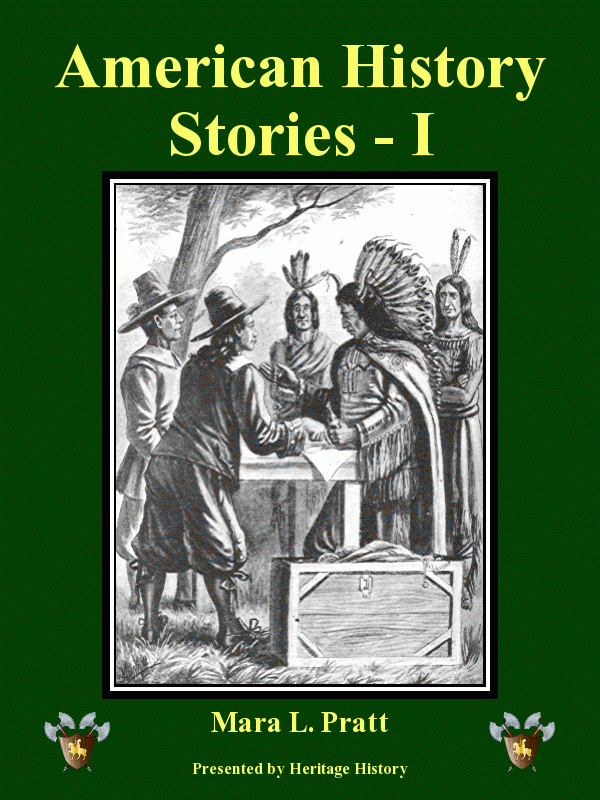 |
American History Stories—Volume
I by Mara L. Pratt
This first of a four volume series written for older grammar school children covers
American History from the landing of Columbus through the French and Indian Wars. The
voyages of Francis Drake, the landing of the Pilgrims, the founding of New York and
Philadelphia, the Salem witchcraft trials, and King Philips's War are some of the other
topics covered. The series is nicely illustrated and organized in short, easily read
chapters.
[59 sheets]
|
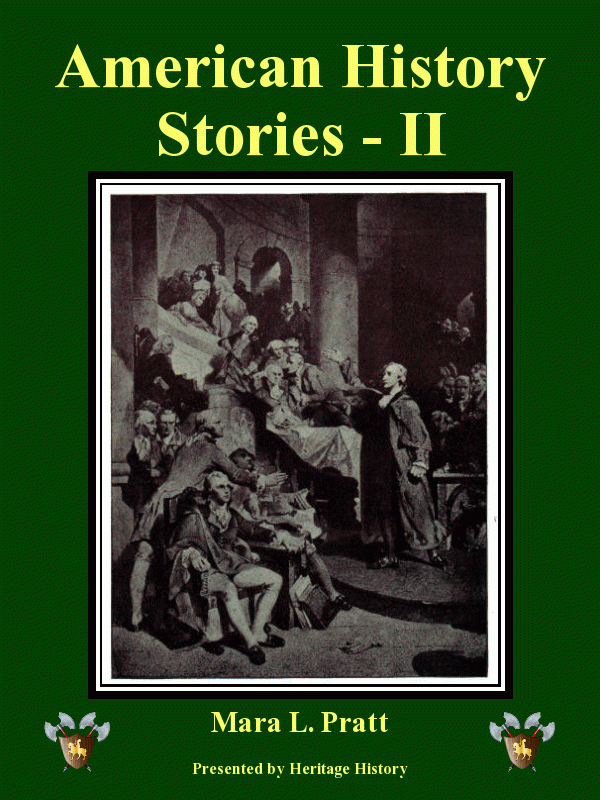 |
American History
Stories—Volume II by Mara L. Pratt
This second volume in Pratt's American History Series covers the Revolutionary War in
Detail. It tells a variety of short stories about interesting events associated with the
Revolution, including the Boston Tea Party, Paul Revere's ride, the Capture of
Ticonderoga, the winter at Valley Forge. It also introduces many of the heroes of the
revolution including Benjamin Franklin, George Washington, Israel Putnam, Lafayette, and
many others.
[59 sheets]
|
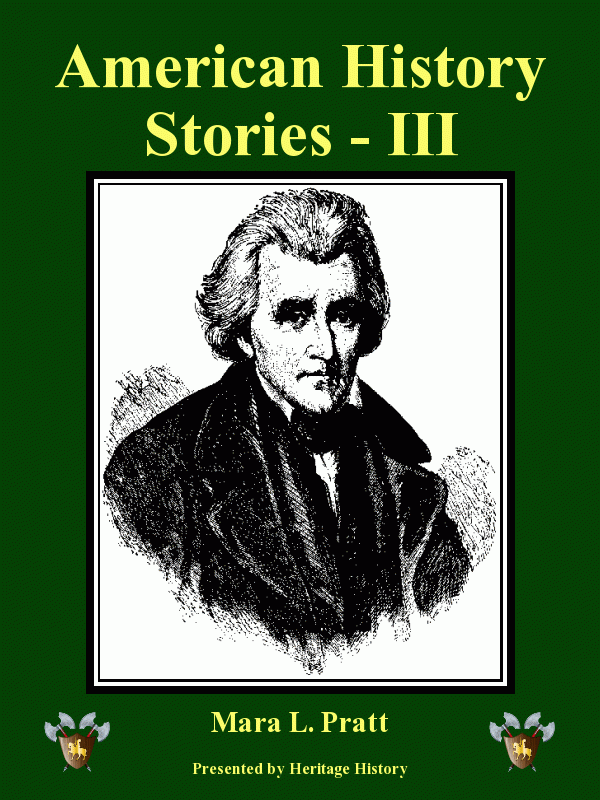 |
American History
Stories—Volume III. by Mara L. Pratt
The third volume in Pratt's American History Series covers the time from the end of the
Revolutionary War to the middle of the 19th century. Topic include the administrations of
Washington and Jefferson, the War of 1812 and various Indian Wars, and interesting
characters such as Andrew Jackson, Daniel Webster, Zachary Taylor, William Henry Harrison,
and John Brown.
[59 sheets]
|
 |
American History
Stories—Volume IV by Mara L. Pratt
The fourth volume in Pratt's American History Series covers the Civil War from the
beginning of Lincoln's first term to his assassination following the Union victory. In
addition to military history, such as the battles of New Orleans, Vicksburg and
Gettysburg, and Sherman's march to the sea, cultural subjects are discussed. Sketches of
the lives of slaves, hymns and folksongs, and civil war era folktales are interspersed
with the story of the progress of the war.
[74 sheets]
|
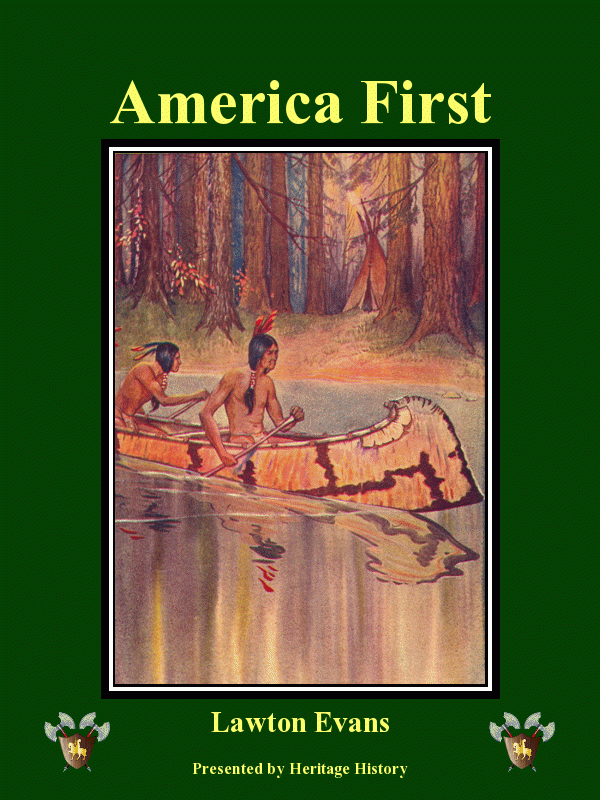 |
America First by Lawton Evans
This delightful collection of stories from America's past recounts one hundred
interesting and romantic incidents from America's history, and provides character sketches
of dozens of early American heroes and heroines. It makes no attempt to relate or explain
complicated government issues and does not provide a chronological or comprehensive
account, but instead focuses on interesting stories and reads like a book of fairy tales.
[151 sheets]
|
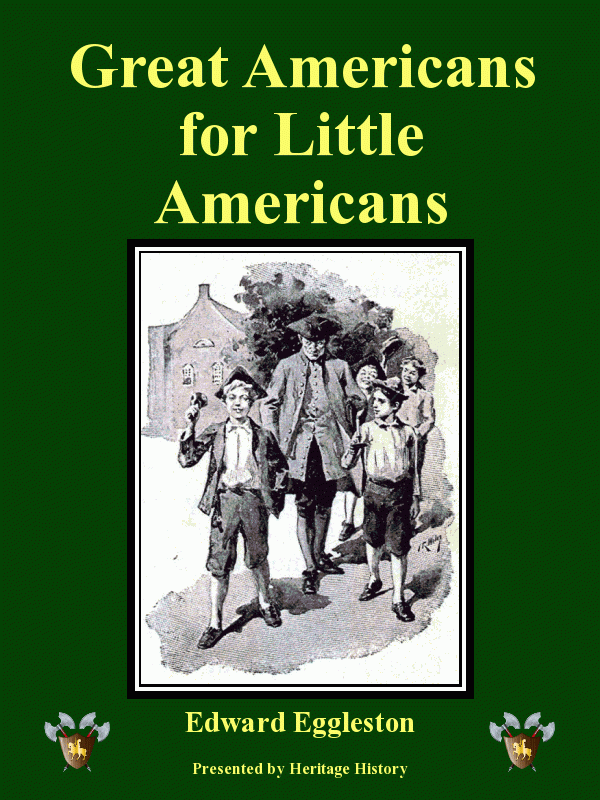 |
Stories of Great Americans for Little
Americans by Edward Eggleston
This book is a popular introduction to American history for very young readers. It
contains dozens of simply told stories of warriors, statesmen, explorers, scientists,
inventors, men and women of letters, and other famous Americans. Featured are Marquette in
Iowa, Penn and the Indians, Thomas Smith and the beginning of rice culture in South
Carolina, Franklin and the ants, Putnam and the wolf, and dozens of other stories. The
collection of sketches features inspirational stories as well as short histories.
[60 sheets]
|
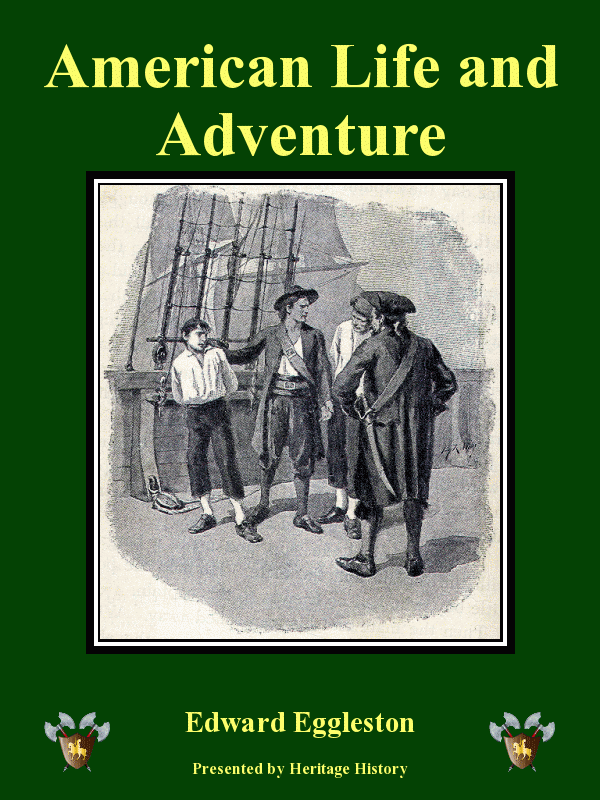 |
American Life and
Adventure by Edward Eggleston
This book is a companion to Eggleston's well known Stories of Great Americans for
Little Americans. While the former volume focused mainly on statesmen, soldiers, and
inventors, this volume contains thirty fascinating stories from America's early years that
do not relate to political history. Instead they are drawn to reflect the adventures and
unusual incidents of explorers, colonists, sailors, townsfolk, and regular citizens.
[84 sheets]
|
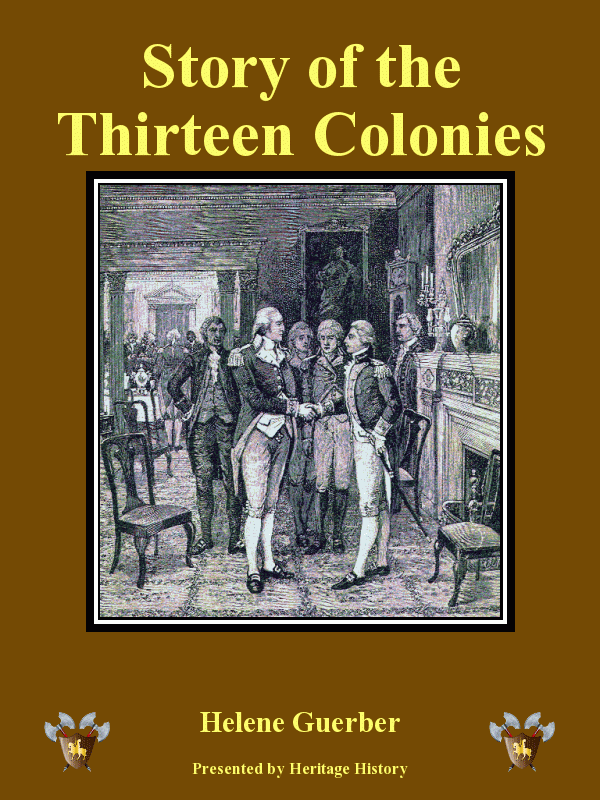 |
Story of the Thirteen
Colonies by Helene Guerber
This book is the first part of a two book series written to provide a comprehensive
history of the United States to middle school aged children. It begins with the
explorations of Columbus, tells the story of the founding of each of the American
colonies, and ends with the Revolutionary War, which severed the colonies from the British
Empire. Its companion book, The Great Republic covers American history from the
Revolutionary war to the early 20th century.
[141 sheets]
|
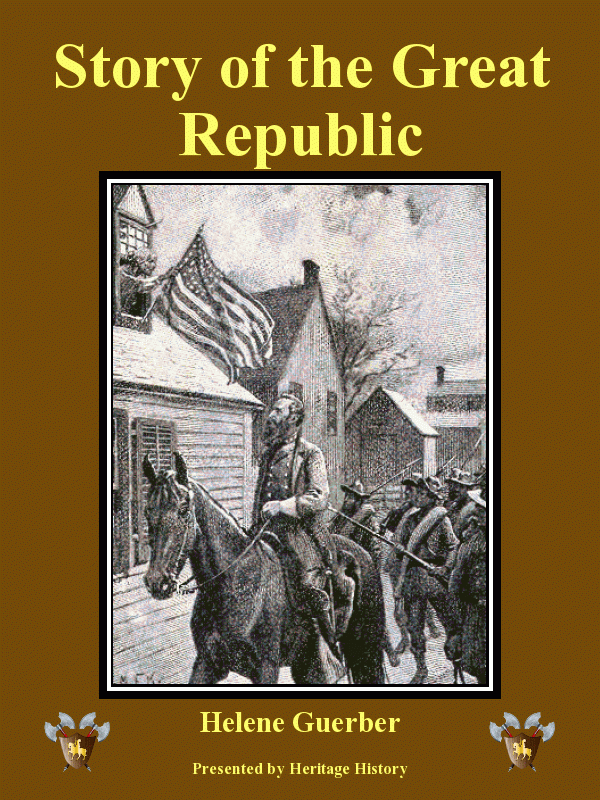 |
Story of the Great
Republic by Helene Guerber
This book is the second volume of Guerber's American history series. It covers United
States history from just after the Revolutionary War to the beginning of the 20th century.
Guerber uses short, story-based based narratives, each based on a particular character or
incident, to tell the story of America from the founding throughout the 19th century. An
excellent introduction to American history for middle school students.
[151 sheets]
|
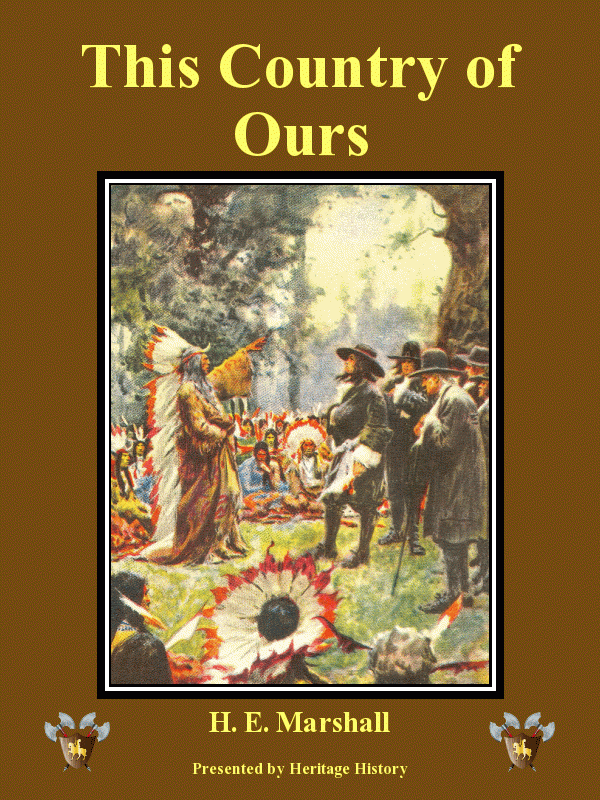 |
This Country of Ours by
H. E. Marshall
Marshall's history of the United States begins with a full account of the English
exploration and settlement of North America and ends with the presidency of Woodrow
Wilson. Nearly 100 stories from American history are grouped under 7 headings: Stories of
Explorers and Pioneers, Stories of Virginia, Stories of New England, Stories of the Middle
and Southern Colonies, Stories of the French in America, Stories of the Struggle for
Liberty, and Stories of the United States under the Constitution.
[276 sheets]
|
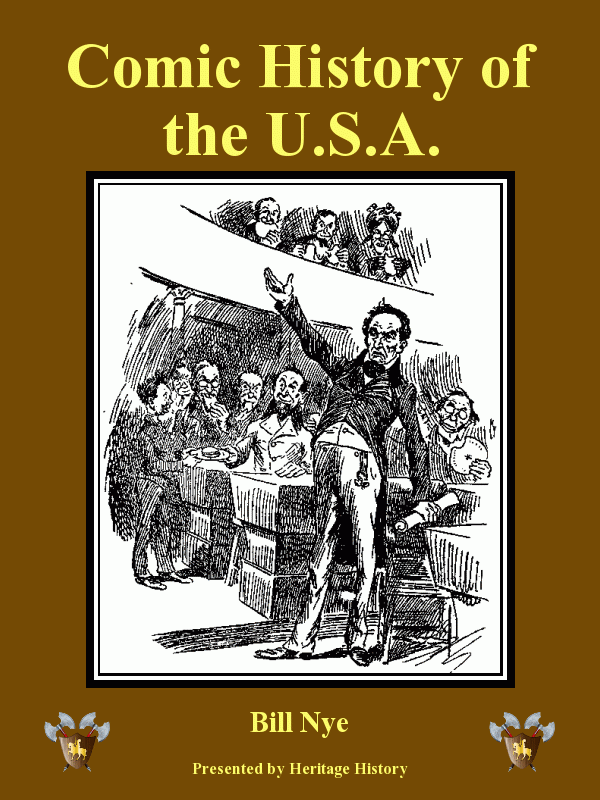 |
Comic History of the United
States by Bill Nye
This delightful book tells the history of the United States from colonial times to the
years following the civil war, from a humorous perspective. It is illustrated with dozens
of cartoon style illustrations and the author's insights into many of the incidents of
American history are insightful as well as humorous. Bill Nye was an American humorist of
the late 19th century who founded the Laramie Boomerang, in Wyoming territory.
[126 sheets]
|
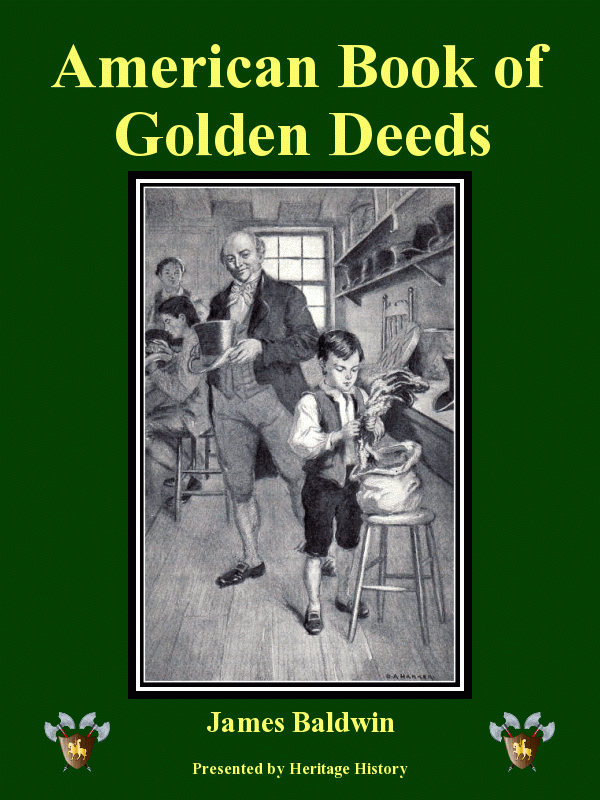 |
American Golden Deeds
by James Baldwin
Forty four short and inspiring stories of heroism and personal sacrifice made by
Americans for the benefit of their community or their country. Most of the subjects of
these stories are every day citizens rather than famous leaders but their noble deeds are
worthy of note.
[98 sheets]
|
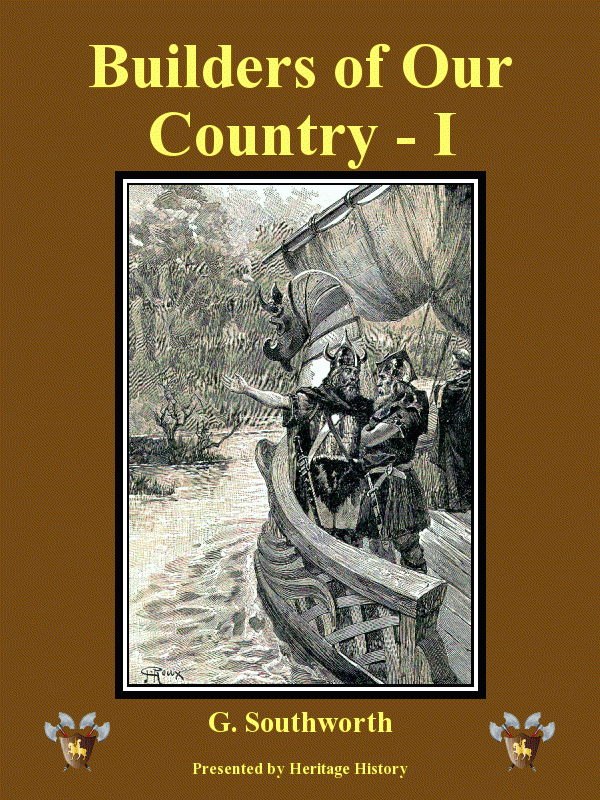 |
Builders of Our
Country - I by Gertrude Southworth
Short biographies of some of the famous pioneers who first explored America and founded
some of the earliest settlements. Included are stories of Columbus, Cabot, Drake, Raleigh,
the Pilgrims, Hudson, Roger Williams, the Dutch in New York, Marquette, La Salle,
Baltimore, Penn, Oglethorpe and many more.
[31 sheets]
|
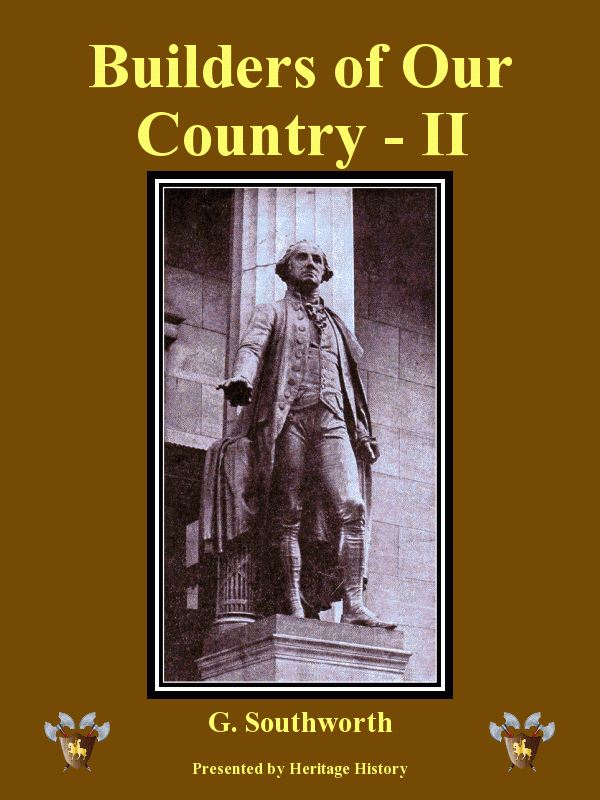 |
Builders of Our
Country - II by Gertrude Southworth
Short biographies of some prominent men who were influential in American history from
the revolutionary period to the opening of the twentieth century. Includes stories of
Patrick Henry, Samuel Adams, Nathaniel Greene, Boone, Whitney, Perry, Jackson, Clay,
Morse, Farragut, McCormick, Edison, and many others.
[136 sheets]
|
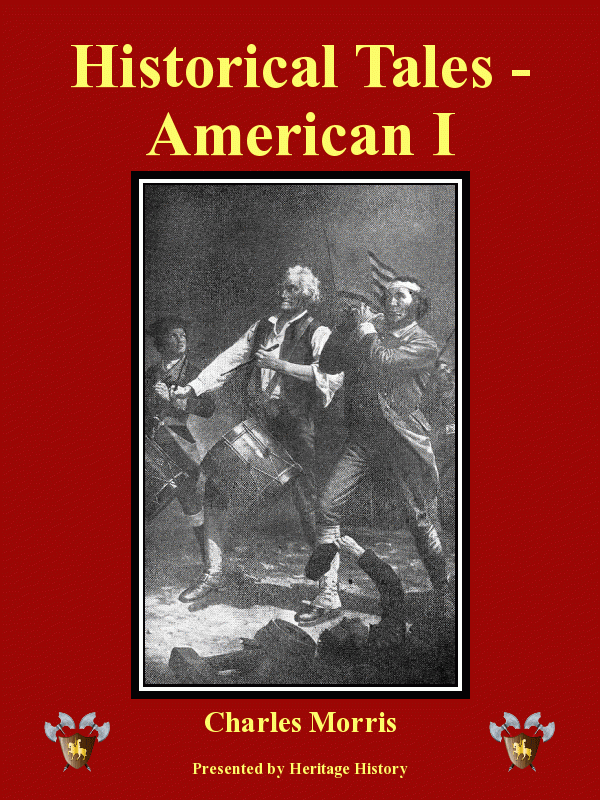 |
Historical Tales - American I by Charles Morris
This is the first of two volumes of stories from American History and covers the colonial
period through the beginning of the civil war. The author has selected a great number of
lesser known but highly interesting stories, usually emphasizing adventure or romance
rather than political significance. Some of the lesser known but entertaining characters
include Sir William Phips, Israel Putnam, Elizabeth Zane, Lydia Darrah, and Francis
Marion.
[136 sheets]
|
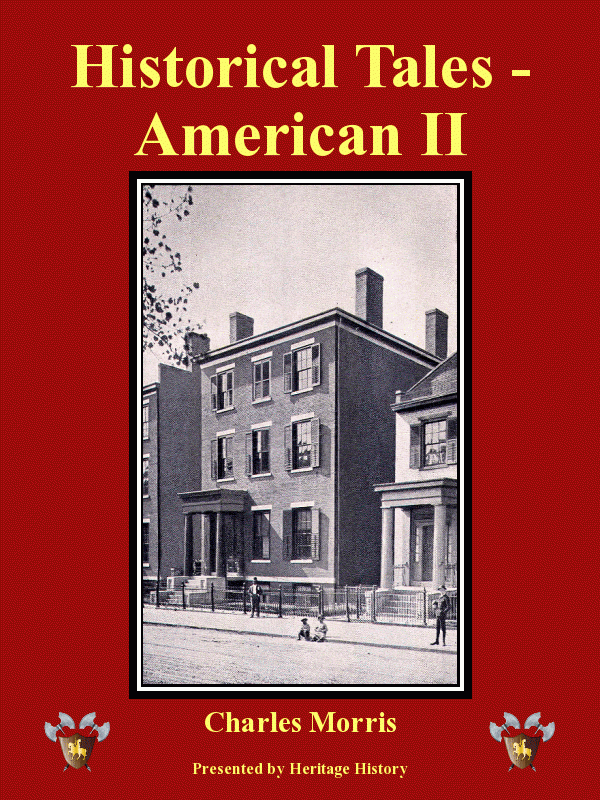 |
Historical Tales - American II by Charles Morris
The second volume of Morris's American Tales focus primarily on stories the occurred in
the Southeast. Short accounts of some of the earliest explorers, including Ponce de Leon,
de Soto, John Smith, and La Salle are given, followed by several chapters dedicated to
Indian Wars, the colonization of the South, and the Mexican-American War which resulted in
the annexation of Texas and much of the Southwest. The last dozen chapters are all
dedicated to stories of interest which occurred during the American Civil War.
[135 sheets]
|
Regional History
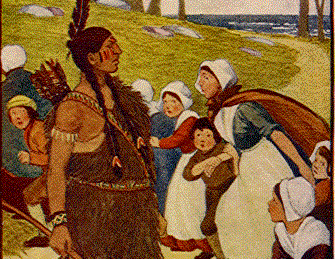
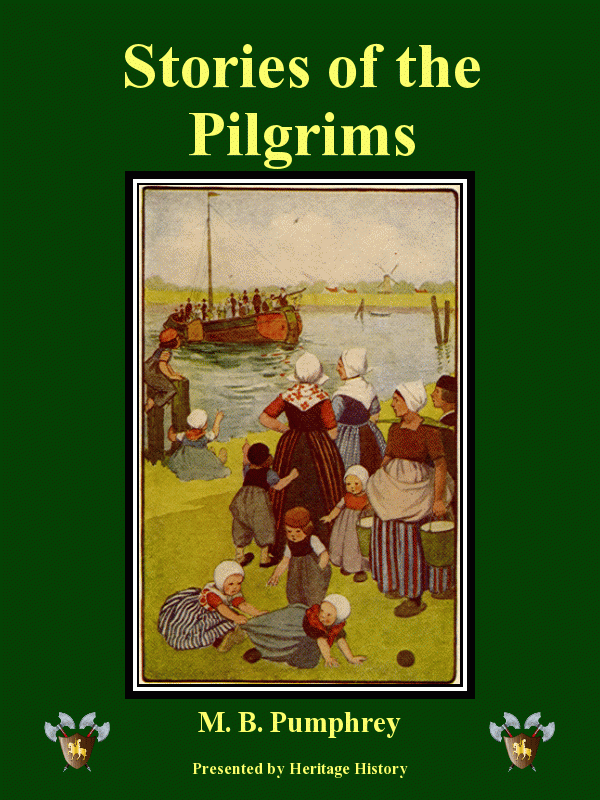 |
Stories of the Pilgrims by Margaret Pumphrey
Beginning with Queen Anne's visit to Scrooby inn, this book tells stories of the
everyday life of the Pilgrims in England and Holland, of their voyage on the Mayflower and
of their adventures in the New World. The Brewster children and other Pilgrim boys and
girls are the center of interest. A wonderful book to read aloud in the weeks before
Thanksgiving.
[82 sheets]
|
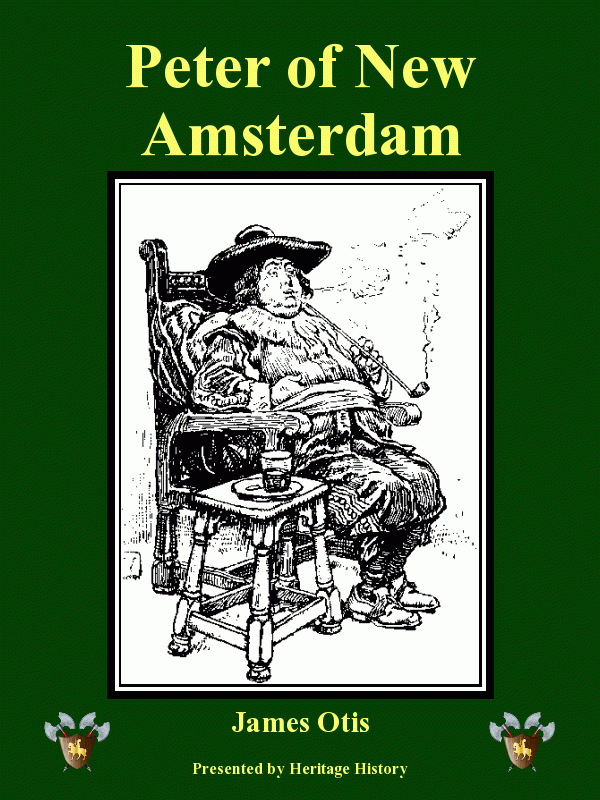 |
Peter of New Amsterdam by James Otis
This book tells the story of Peter, an orphaned Puritan living in the Holland who is
sent as a worker to New Amsterdam (now New York), in the New World. He comes of age
during the Anglo-Dutch war that led to the Dutch colony falling into the hands of the
English, and the story of his life introduces students to contemporary customs and
historical events.
[64 sheets]
|
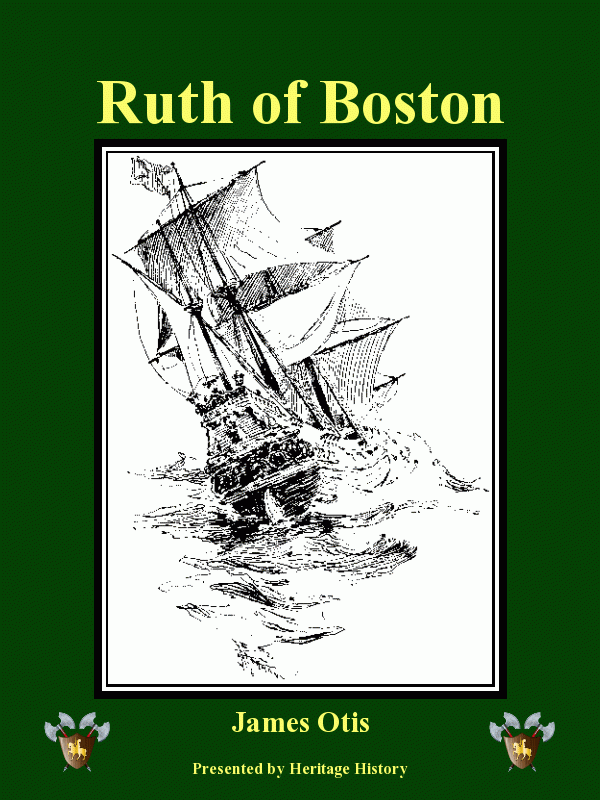 |
Ruth of Boston by James Otis
This book follows the story of Ruth, a Puritan girl of ten who travels to the new world
and is one of the earliest settlers of the New England colony that formed around Boston.
The book emphasizes episodes from the daily life of a Puritan settler, such as preparing
food, attending church and school, and doing household chores. Relations with the Indians
and historical events are all portrayed from a Puritan's viewpoint.
[67 sheets]
|
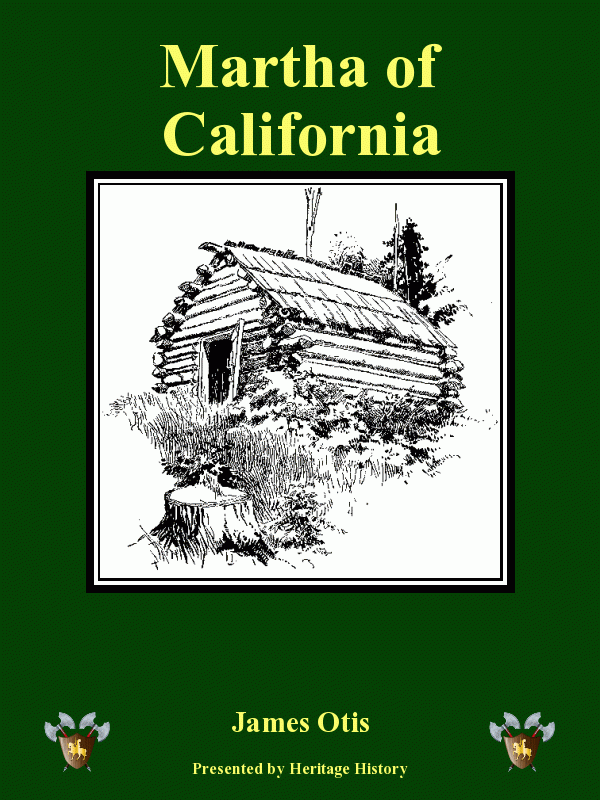 |
Martha of California by James Otis
This book follows the life of Martha, a young girl from Missouri who travels to
California by way of the Oregon trail. The story is told in the first person by a young
lady who travels with her family in a covered wagon and relates the adventures encountered
on the trail, including confrontations with Indians, night time travel over deserts and
salt fields, hunting excursions, and difficulties with livestock and provisions.
[58 sheets]
|
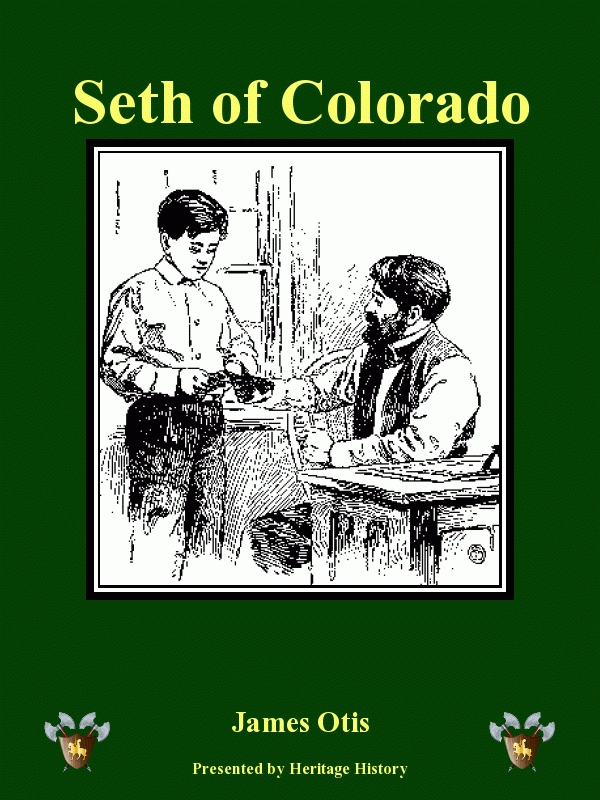 |
Seth of Colorado by James Otis
This book tells the story of Seth, a young man who travels to Colorado with a family
intent on homesteading in the area. After farming for a short time, Seth opens a store in
the pioneer town of Auraria, across the river from an outpost at Denver. The families
survive fires and flood and eventually see Denver grow into a substantial town.
[60 sheets]
|
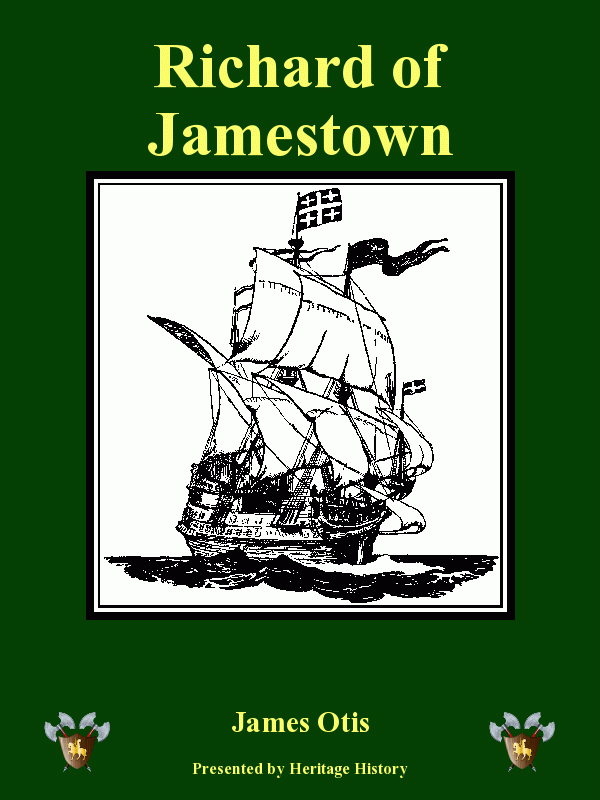 |
Richard of Jamestown by James Otis
This book follows the life of Richard, a poor boy from London, who finding himself
homeless and alone in the world, sets sail with Captain John Smith for the Jamestown
colony in the new world. The book closely follows the historical events recorded by John
Smith, but they are relayed from a young boys point of view and emphasis issues related to
daily life, such as hunting and building fortifications, as well as historical events.
[68 sheets]
|
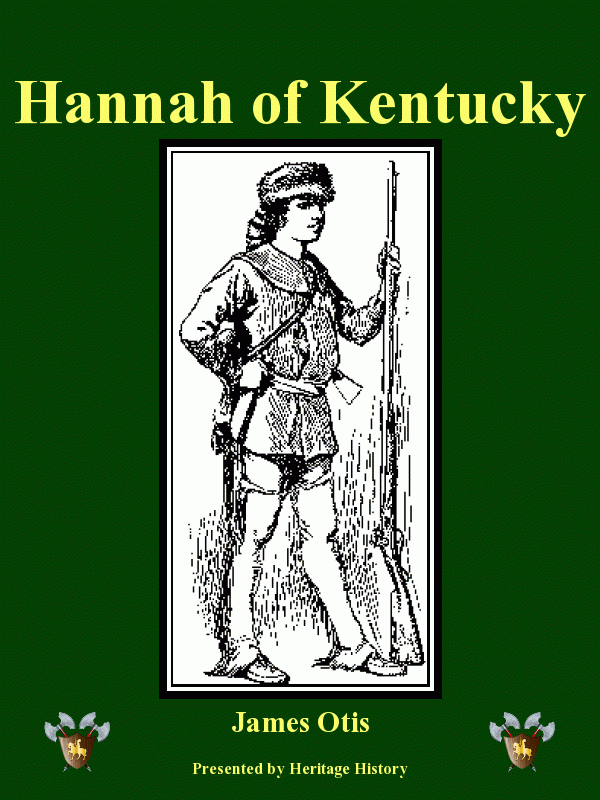 |
Hannah of Kentucky by James Otis
This book recounts the story of Hannah, whose family is closely associated with that of
the great pioneer, Daniel Boone. Her father follows Boone to the wilderness fortress at
Boonesborough and shares in many of his adventures. The story emphasizes the daily
activities of pioneer life in a remote fortification, but also touches on historical
events related to the siege of Boonesborough in 1778.
[62 sheets]
|
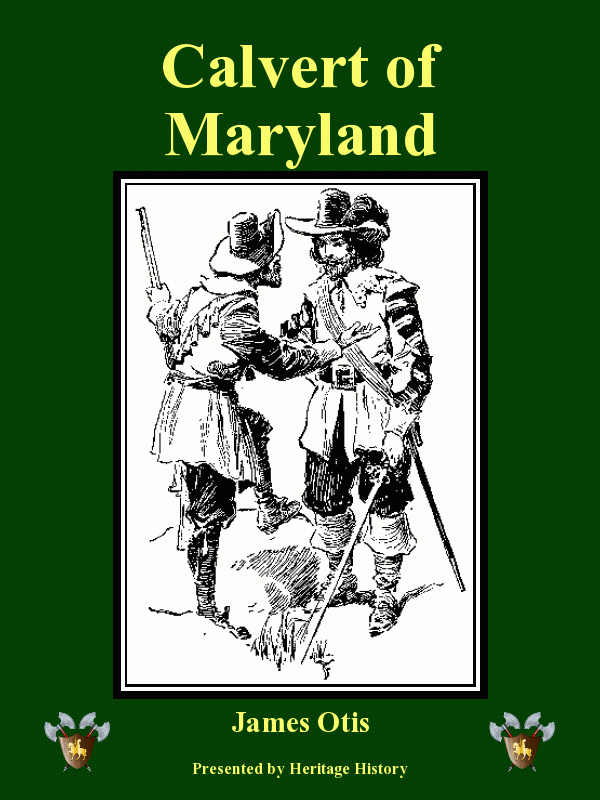 |
Calvert of Maryland by James Otis
This book follows the life of Calvert, who together with his father settles in the newly
established Catholic colony in Maryland. Although they have many adventures with Indians,
conflicts with other colonists provide much of the action in the narrative.
[68 sheets]
|
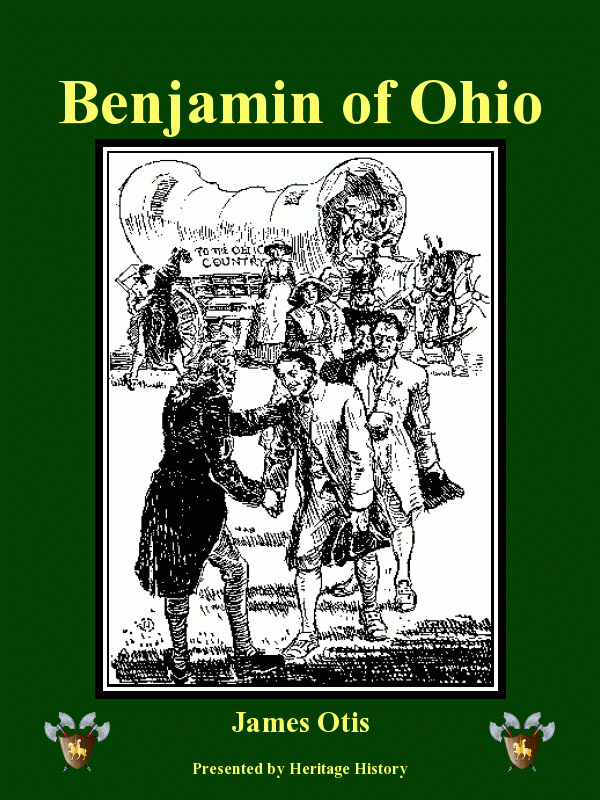 |
Benjamin of Ohio by James Otis
This book follows the story of Benjamin who joins the exploration and settlement party
of Rufus Putnam and helps to establish the Marietta, the first American settlement in the
Ohio River valley. The settlers have to combat weather, Indians, and raging rivers as they
travel on flatboats to their destination.
[64 sheets]
|
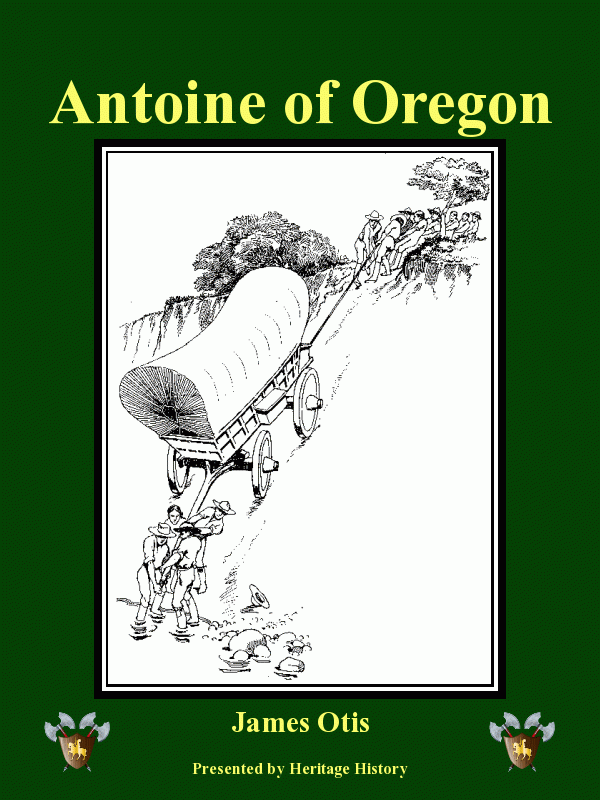 |
Antoine of Oregon by James Otis
This book follows the story Antoine, son of a French trader who first traveled over the
Oregon trail with his father. After his father dies he is hired as a young guide for a
group of settlers who seek to cross the Rockies in covered wagons. Even at a young age,
he has more experience in unsettled regions than most of other travelers, and his
conflicts with older members of the party provide considerable drama on the journey.
[60 sheets]
|
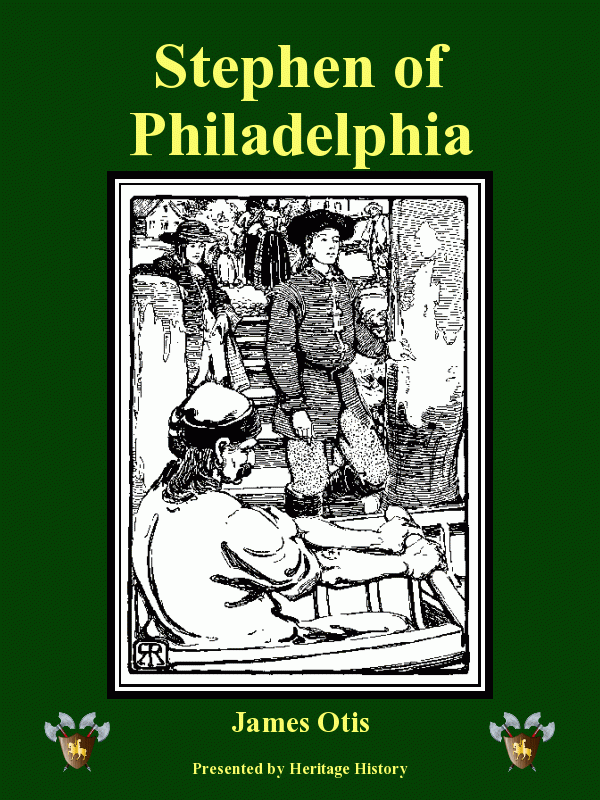 |
Stephen of Philadelphia by James Otis
This book follows the life of a young Quaker boy from London whose goes to settle the
New World with a group of colonists sent by William Penn. The story covers the earliest
days of the settlement that would grow to became Philadelphia and emphasizes both the
industry and resourcefulness of the settlers and the complicated religious and political
differences between the Quaker and other colonists.
[69 sheets]
|
 |
Mary of Plymouth by James Otis
This book follows the life of Mary of Plymouth, a young girl who arrives with the
Pilgrims on the Mayflower and shares in their difficulties and adventures. It is
very authentic in both in portraying the daily life and work of the early settlers, and in
depicting the attitude of many of the pilgrims towards Indians, other settlers, and
Englishmen with less than orthodox Puritan views.
[63 sheets]
|
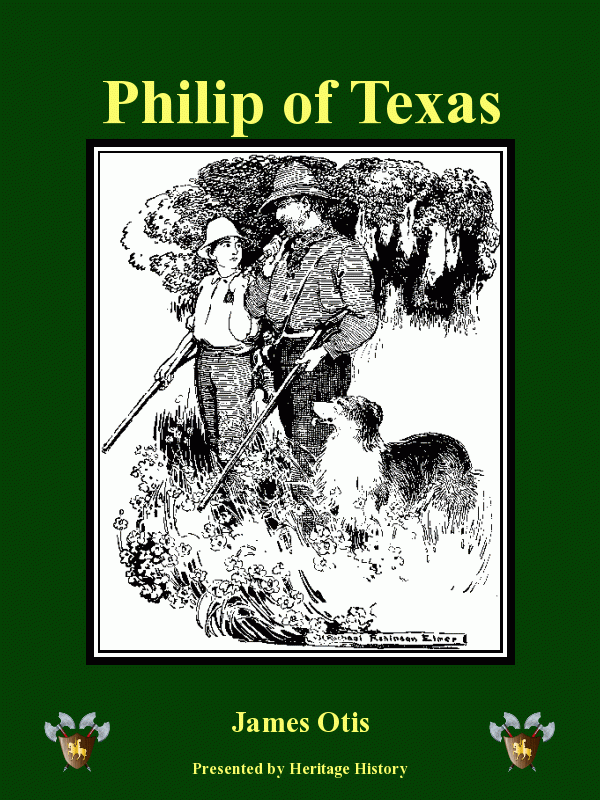 |
Philip of Texas by James Otis
This book tells the story of Philip, a young man who with his parents,
migrates to the northern regions of Texas territory in order to raise sheep.
Interesting incidents include a severe flood, an attack by wild boars,
dealings with smugglers and other settlers, and events leading up to the
Mexican-American War.
[60 sheets]
|
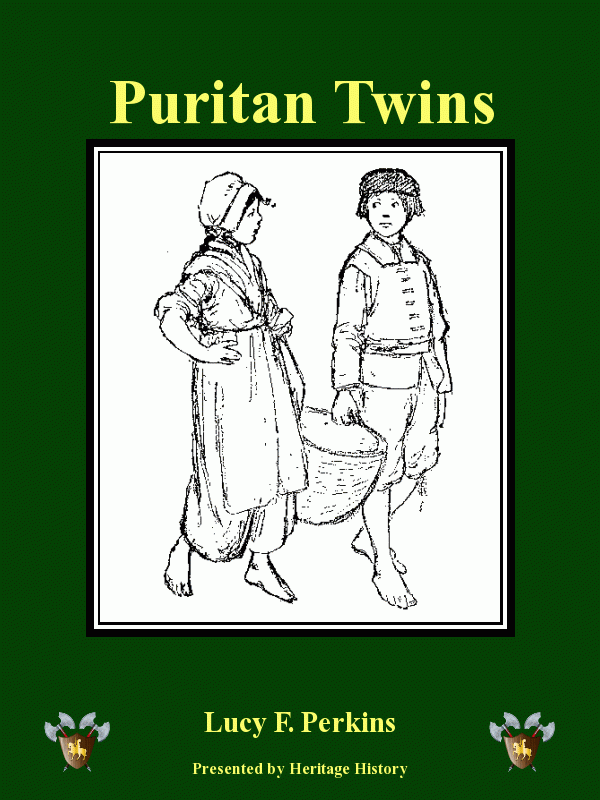 |
Puritan Twins by Lucy Fitch Perkins
Daniel and Nancy are 12 year-old twins growing up in Puritan New England during the
seventeenth century. As the children of farmers, much of their time is spent helping their
parents around the homestead, but the family has an opportunity to go on a sailing
expedition and returns to Plymouth rock, the landing place of the pilgrim fathers.
[47 sheets]
|
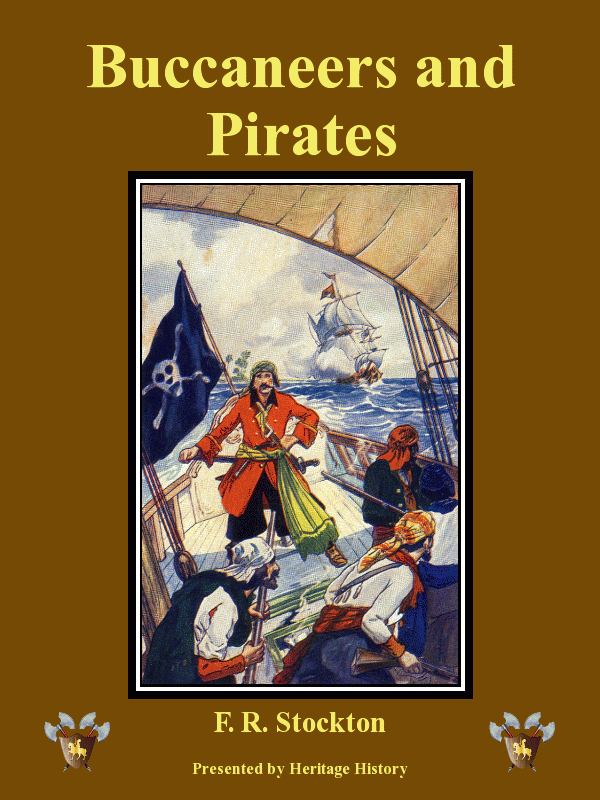 |
Buccaneers and Pirates of Our Coast by Frank Stockton
This swashbuckling set of pirate tales makes for a grand feast of adventure stories.
With chapters such as Masters in Piracy, A Pirate Potentate, and
Villainy on a Grand Scale the author recounts the dastardly deeds and
desperate feats of dozens of pirates who terrorized the Caribbean Coasts. There
is no shortage of action in this book; most horrifying exploits are rendered in
reasonably good taste, and many of the tales are surprisingly amusing.
[101 sheets]
|
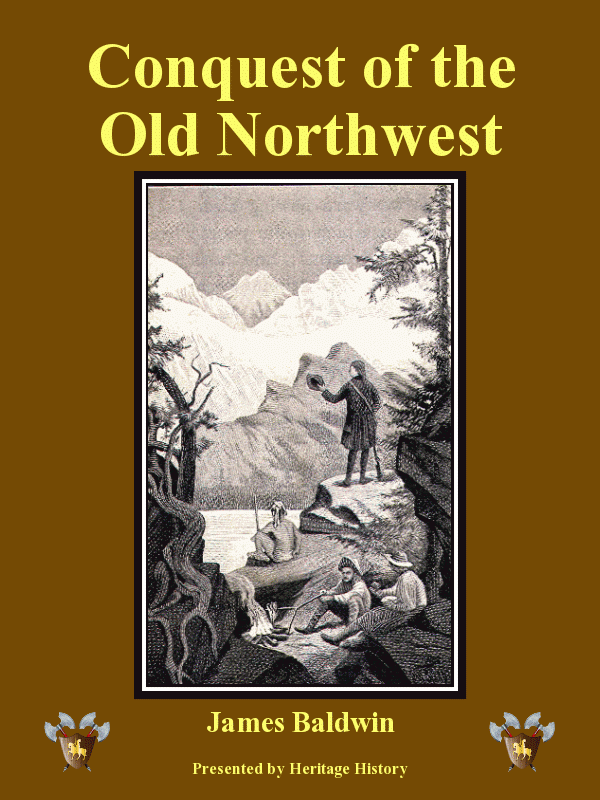 |
Conquest of the Old Northwest by James Baldwin
This book is the second part of Baldwin's history of the discovery and settlement of the
Ohio Valley. It begins with an overview of the rival claims between the French and
English. Although most of the earliest settlers were French, by the end of the 18th
century England became predominant. Introduces lesser known French and English heroes of
the region, such as Juchereau, Vincennes, Joncaire, Carver, and Clark, as well as the
predominant Indian chiefs of the era.
[111 sheets]
|
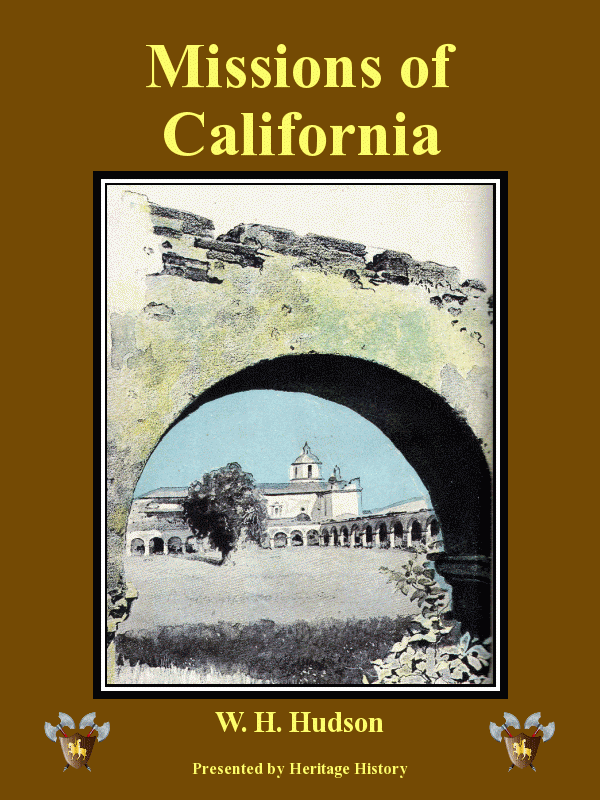 |
Missions of California by William Henry Hudson
This short book tells the complete story of the founding of the Franciscan Missions of
California under Junipero Serra and his followers. Only 80 pages long, it is lavishly
illustrated and provides a short, balanced, and fascinating introduction to early
California history.
[28 sheets]
|
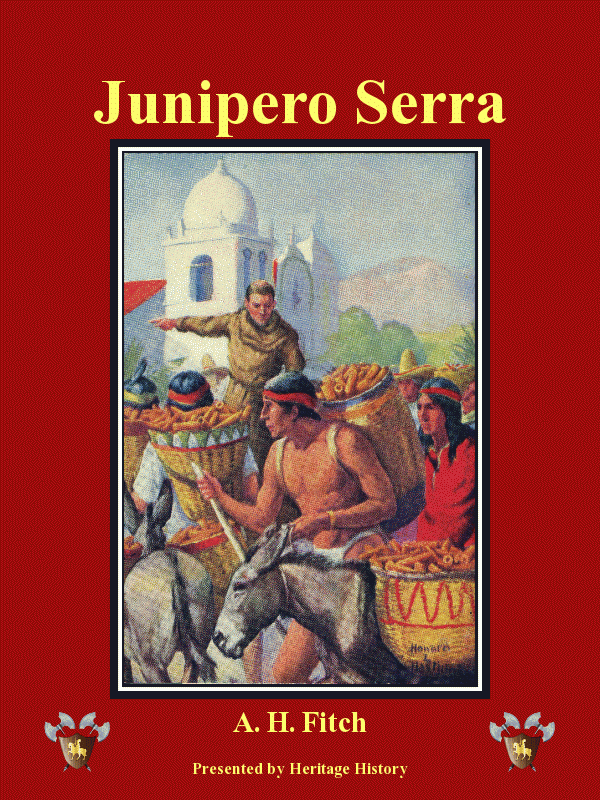 |
Junipero Serra by A. H. Fitch
This biography of Junipero Serra recounts his experience founding missions along the
California coast. It reveals a dedication and patience that almost surpasses belief, for
he was met at every turn with both political and practical difficulties. This history
draws heavily on original sources and provides a highly authentic portrait of the events
surrounding the founding of the California missions, including insight into the lives
native peoples of the regions.
[135 sheets]
|
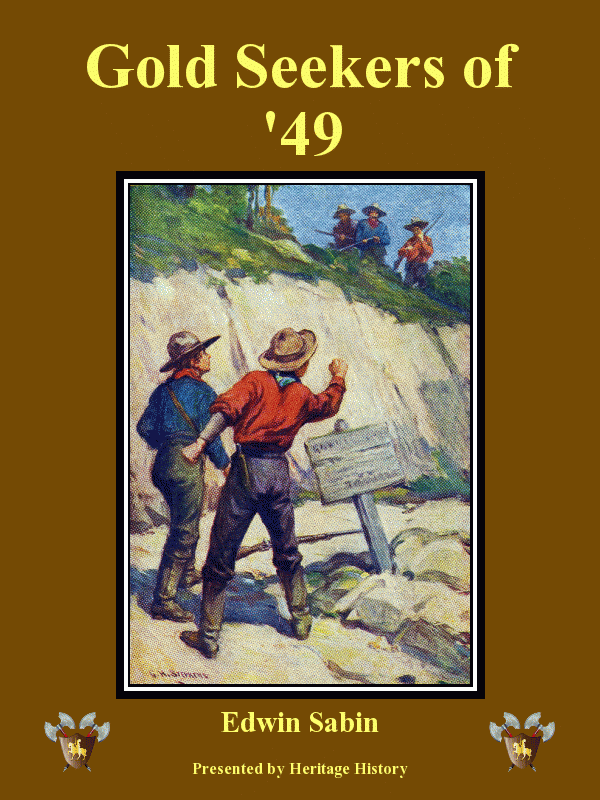 |
Gold Seekers of '49 by Edwin Sabin
This book follows the story of a young man who is lured to the territory of California
during the gold rush of 1849. The first part the book covers his experience on a boat
rounding the Cape of South America, and his introduction to the small town of San
Francisco. His adventures in the gold fields themselves consume the second half of the
book. Although the book is fiction, it accurately portrays the spirit of the California
gold rush.
[134 sheets]
|
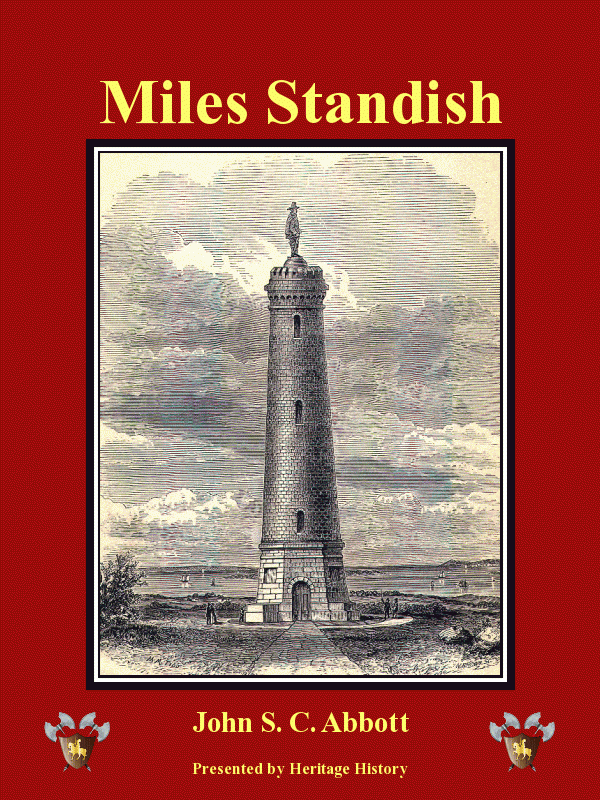 |
Miles Standish by John S. C. Abbott
This biography of Miles Standish tells the thrilling story of the first pilgrim settlers
in the colony of Plymouth. Standish arrived on the Mayflower and was the chief military
leader of the pilgrims. He was exceedingly brave and respected by both Pilgrims and
Indians, and his story is told using many original sources written by the pilgrim leaders
themselves.
[127 sheets]
|
Military History

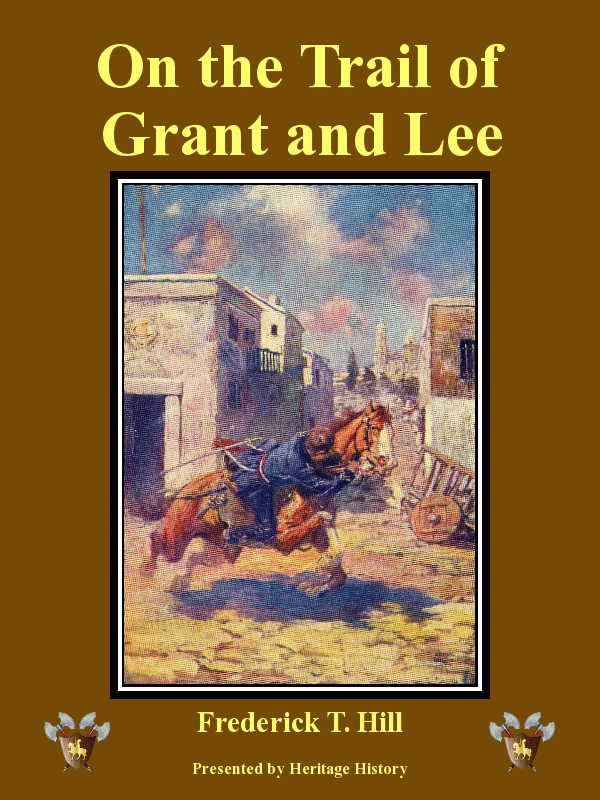 |
On the Trail of Grant and Lee by Frederick Trevor Hill
This middle school biography tells the story of the Civil War from the vantage point of
its two most famous antagonists, Robert E. Lee and Ulysses S. Grant. Both characters are
treated sympathetically, and the most interesting incidents of each of their lives are
touchingly retold. By presenting the best sentiments, aims, and heroics of both sides,
the full tragedy of the Civil war is fully recounted.
[98 sheets]
|
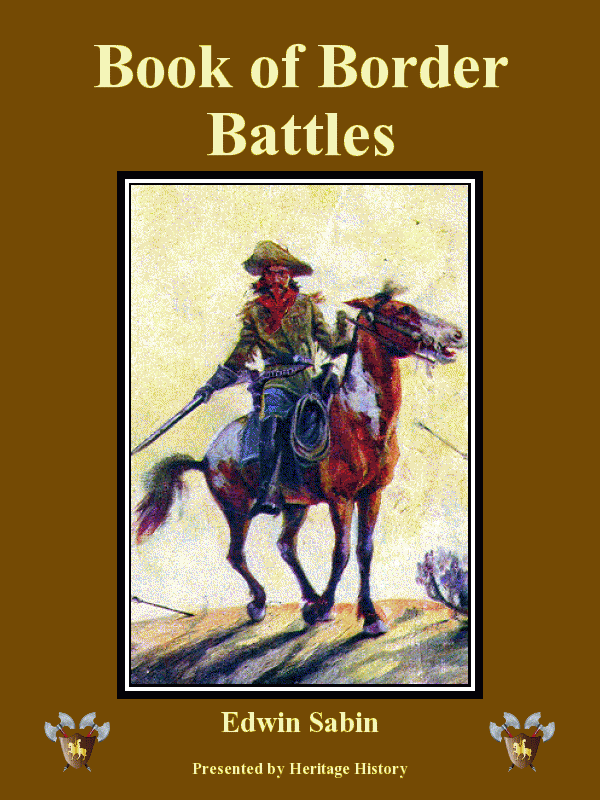 |
Boys' Book of Border Battles by Edwin Sabin
This is the final book in the Frontier Fighter series from Edwin Sabin that
covers many of the battles in American history fought on the frontiers and borders of the
expanding American nation. His other two books cover many of the wars with Eastern and
Western Indian tribes. The final book contains a few pre-revolutionary wars with
Indians, but is mostly dedicated to the Spanish-American War in the South and the Sioux
War on the northern plains.
[141 sheets]
|
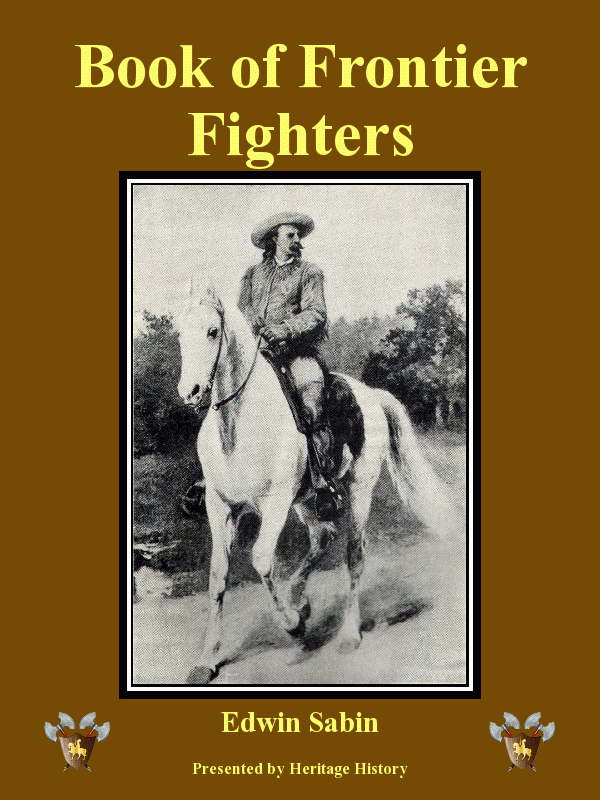 |
Boys' Book of Frontier Fighters by Edwin Sabin
This second book in Sabin's Series of Frontier Fighters features the exploits of
American frontiersmen, including Simon Kenton, Simon Girty, 'Betty' Zane, John Colter,
Samuel Brady, Buffalo Bill, and many more. Many of the stories feature great exploits or
escapes rather than military battle, and tell the stories of many of the frontier heroes
of early American folklore.
[154 sheets]
|
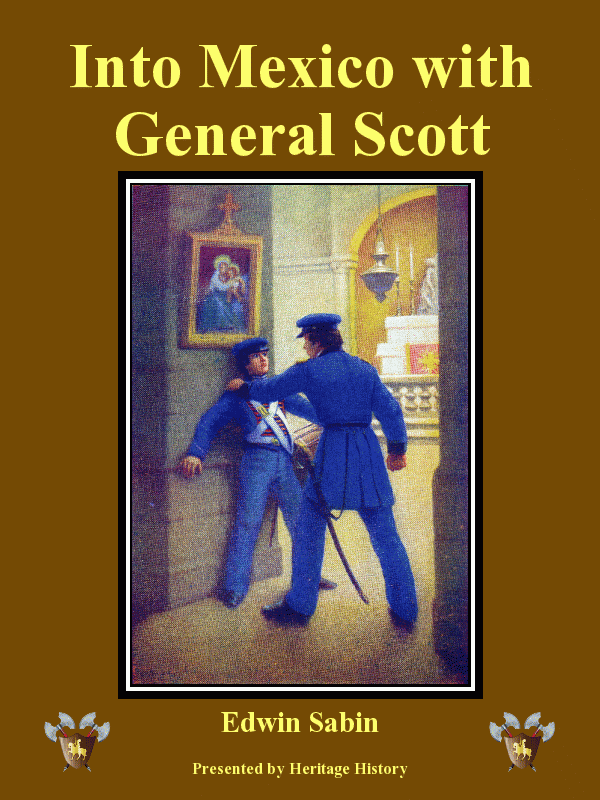 |
Into Mexico with General Scott by Edwin Sabin
This work of historical fiction follows the American Army under Winfield Scott during
the Mexican-American War. The protagonist is a young man who joins the army and serves
under second Lieutenant U. S. Grant. With the rest of the U.S. army, he participates in
the landing of U. S. ships at Vera Cruz, and the march of 200 miles inland in order to
capture the Capital city of Mexico and force a surrender.
[141 sheets]
|
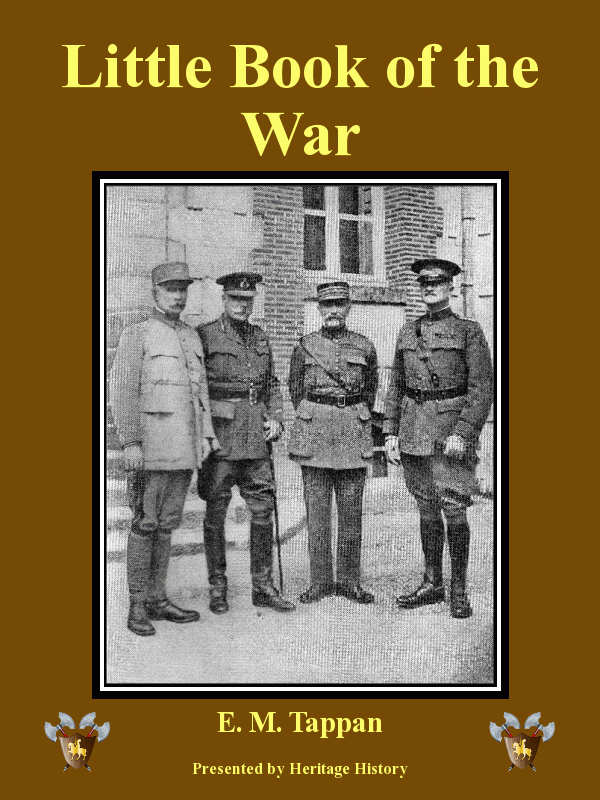 |
Little Book of the War by Eva March Tappan
This book gives a clear and thorough description of the causes and course of the first
world war. The complicated ambitions and grievances of the axis powers, namely Germany,
Austria, and Turkey are first made clear. As the war unfolds and the fronts multiply;
first in France and Eastern Europe, and then later, in Italy, Serbia, and Turkey, an
excellent summary of all major operations are given, as well as an introduction to the new
techniques of 'modern warfare'.
[54 sheets]
|
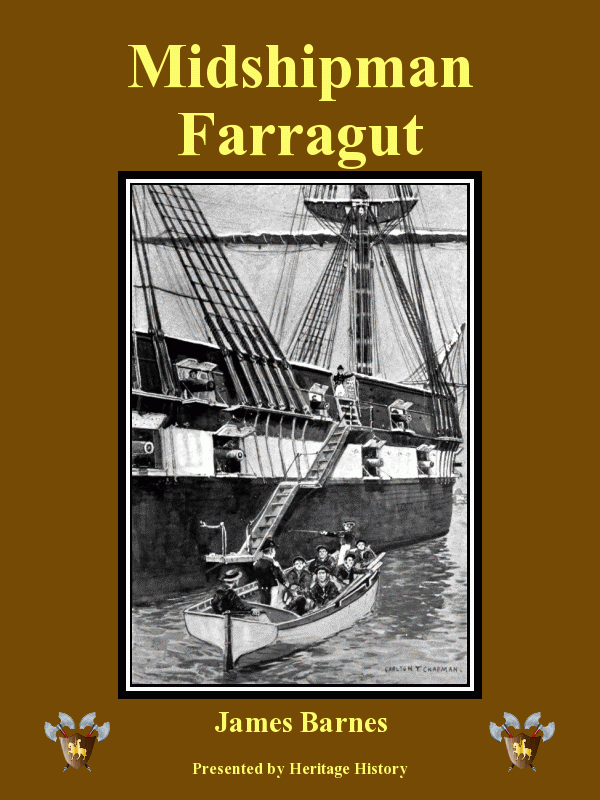 |
Midshipman Farragut by James Barnes
This exciting adventure story follows the boyhood of the Civil War era naval hero David
Farragut during his days as a midshipman during the War of 1812. His escapades on the USS
Essex were as action-packed as his later ventures during the Civil War, and they are the
primary focus of this biography.
[64 sheets]
|
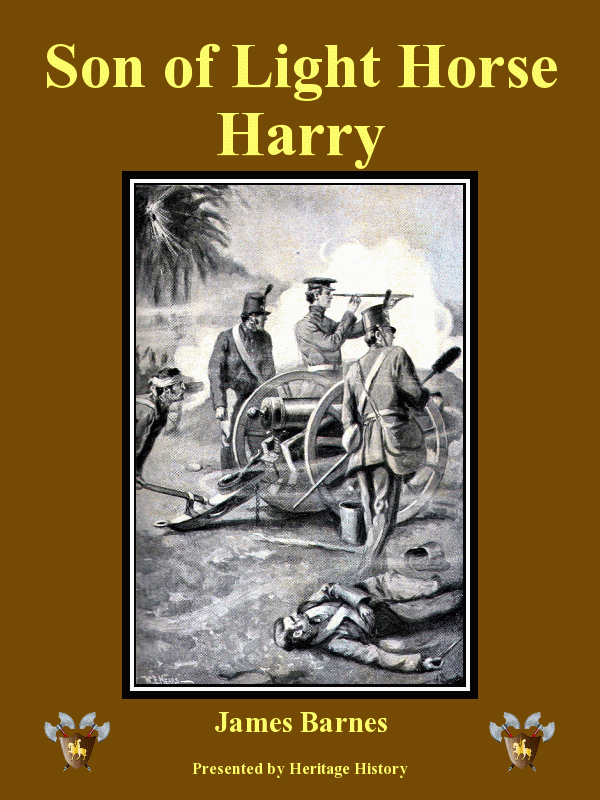 |
Son of Light Horse Harry by James Barnes
'Light Horse' Harry Lee was one of George Washington's most trusted generals during the
Revolutionary War, and his son Robert E. Lee led the confederate army during the Civil
War. This book follows the early years of Robert E. Lee during his youth, education, and
shows how he distinguished himself as an officer in the Mexican-American War and as an
outstanding citizen.
[72 sheets]
|
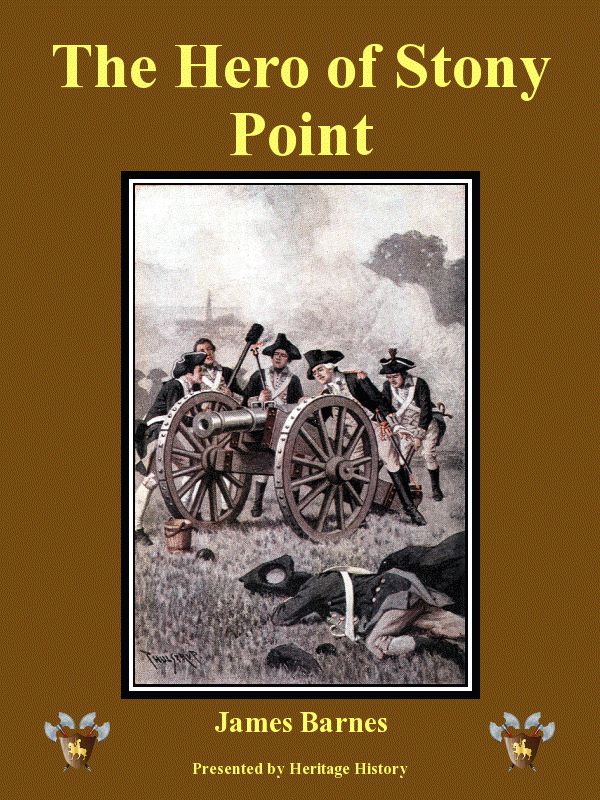 |
The Hero of Stony Point by James Barnes
'Mad Anthony' Wayne was one of Washington's leading generals during the Revolutionary
war, and the hair-raising victory at Stony Point was one of his most heroic actions of the
early war years. Wayne distinguished himself as a great leader, not only in his greatest
moment of victory, but also in numerous battles that ultimately were won by the British.
His heroism never flagged in difficulty or defeat.
[61 sheets]
|
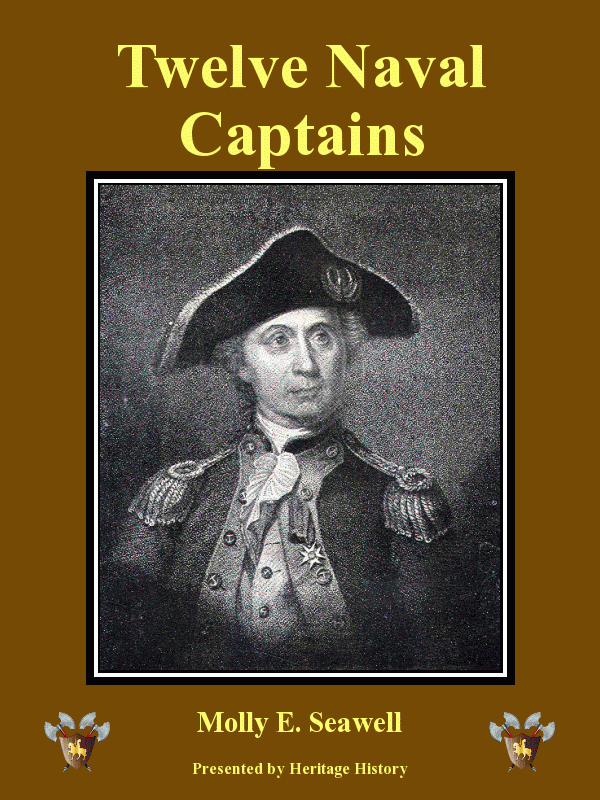 |
Twelve Naval Captains by Molly Elliot Seawell
A dozen stories of the most famous naval heroes in American history are given here.
Written in the late 19th century, it includes only sea-captains who served between 1776
and 1890, but the fascinating stories of John Paul Jones, Steven Decatur, Edward Preble,
and William Bainbridge, among others are given.
[86 sheets]
|
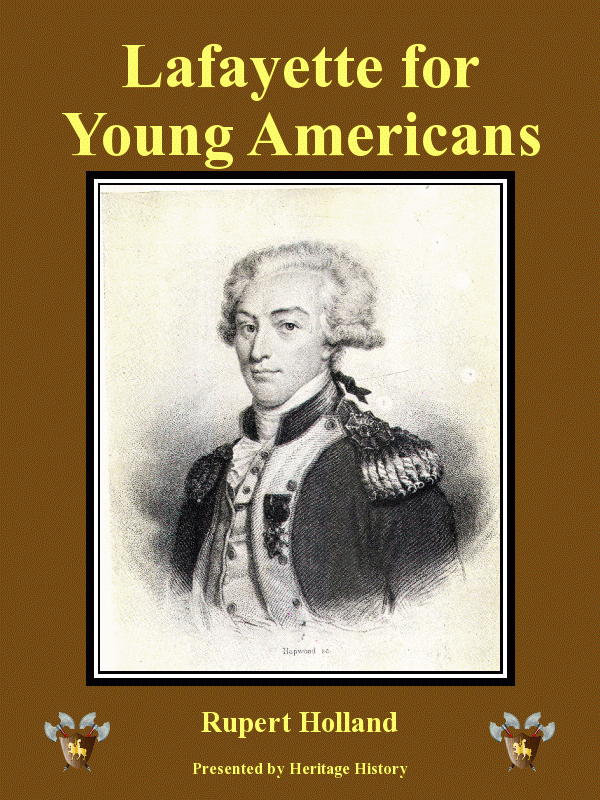 |
Lafayette for Young Americans by Rupert Holland
The book follows the fascinating career of the Marquis de Lafayette from his youth in
France, the years of his heroic service to Washington during the Revolutionary wars,
through his ill-fated service the Revolutionary cause in France. The story of
Lafayette's life provides a fascinating juxtaposition between the successful and laudatory
American revolution, and the far more sanguinary French revolution. The author does an
excellent job of presenting complicated political events in terms comprehensible to middle
school ages students.
[103 sheets]
|
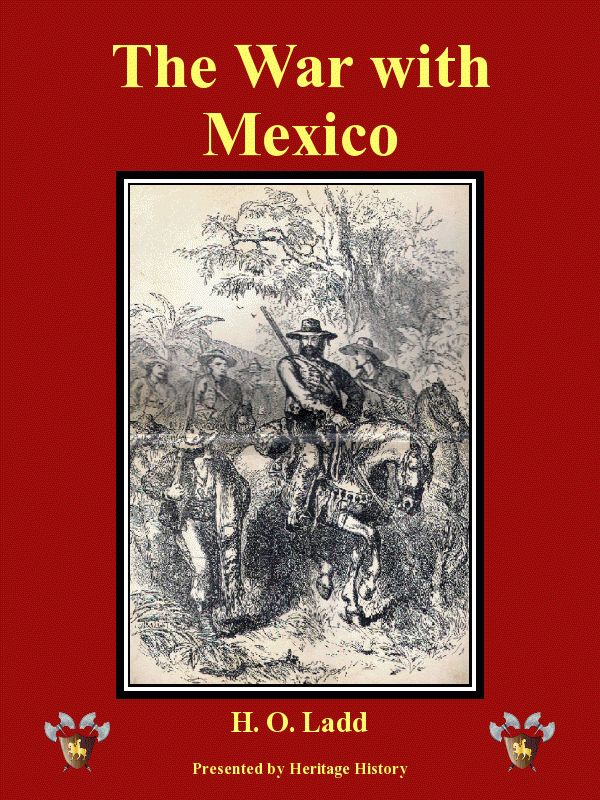 |
The War with Mexico by Horatio O. Ladd
This is a thorough and balanced history of the War between Mexico and America, written
only twenty years after the conflict. It emphasizes the dubious political mechanisms that
led to the war, and the dysfunctional condition of the Mexican government, as well as
American feats of heroism.
[105 sheets]
|
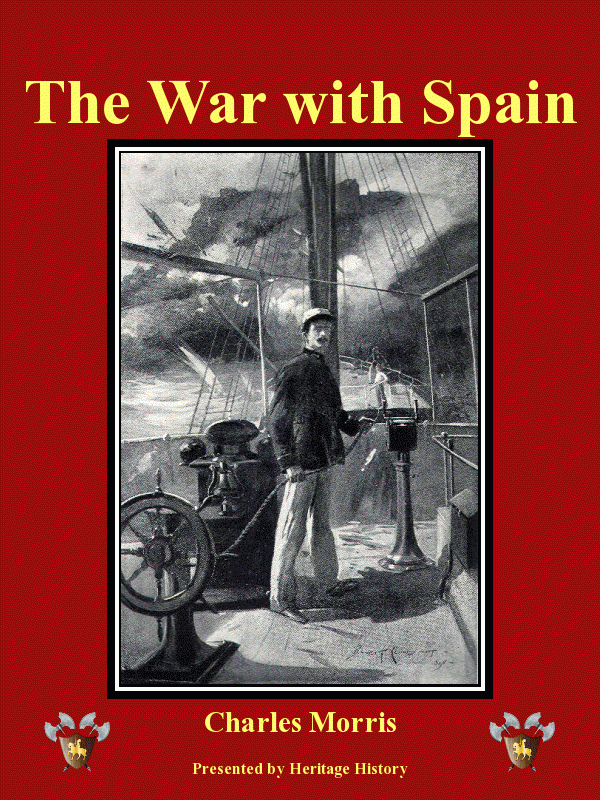 |
The War with Spain by Charles Morris
Detailed, and well written history of the Spanish American War, authored shortly after
the close of hostilities. Strongly presents the American case for the war, and provides
much background in terms of the ongoing rebellions against the Spanish governments in Cuba
and the Philippines which preceded the American invasion.
[169 sheets]
|
Statesmen and Authors
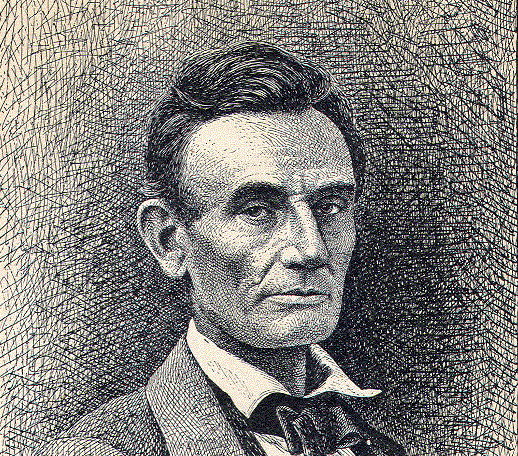
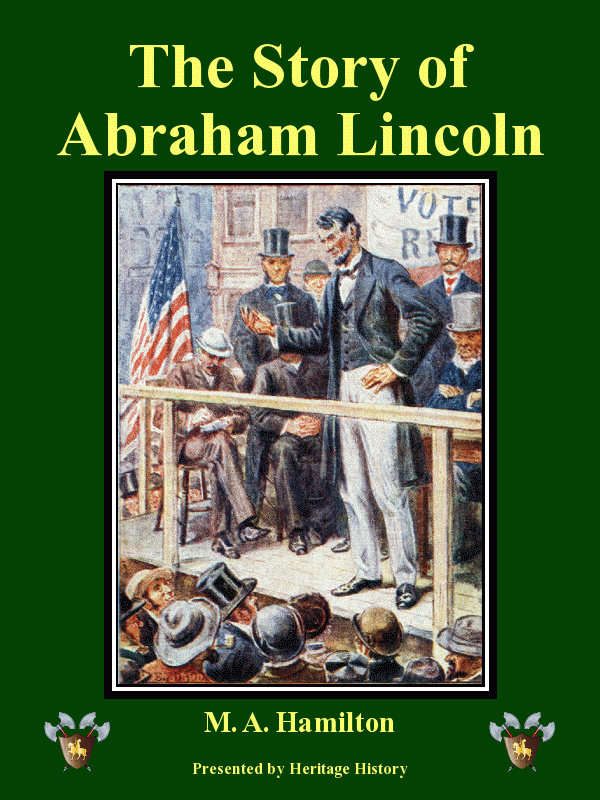 |
The Story of Abraham Lincoln by Mary A. Hamilton
This easy-to-read biography of Abraham Lincoln is accessible to grammar school students,
but detailed enough to give inspiring insights into his character so that his heroism
during the terrible years of the civil war can be fully appreciated. It covers and many
important and informative events from his childhood and recounts the long political career
that eventually led to the White house. The final chapters deal with his leadership
during the country's greatest trial.
[39 sheets]
|
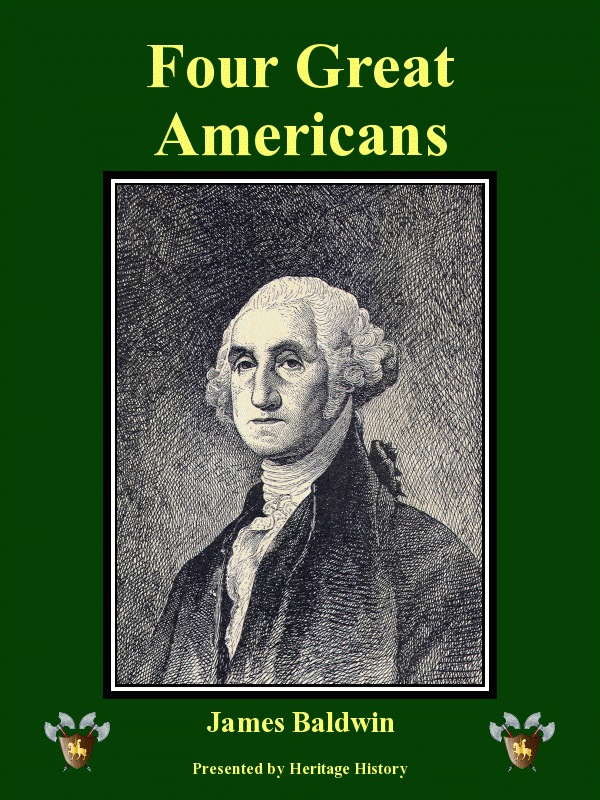 |
Four Great Americans by James Baldwin
Elementary level biographies of four prominent American statesmen: George Washington,
Benjamin Franklin, Daniel Webster, and Abraham Lincoln. The author emphasizes their
childhoods and early careers rather than their political achievements in order to hold the
interest of young children.
[74 sheets]
|
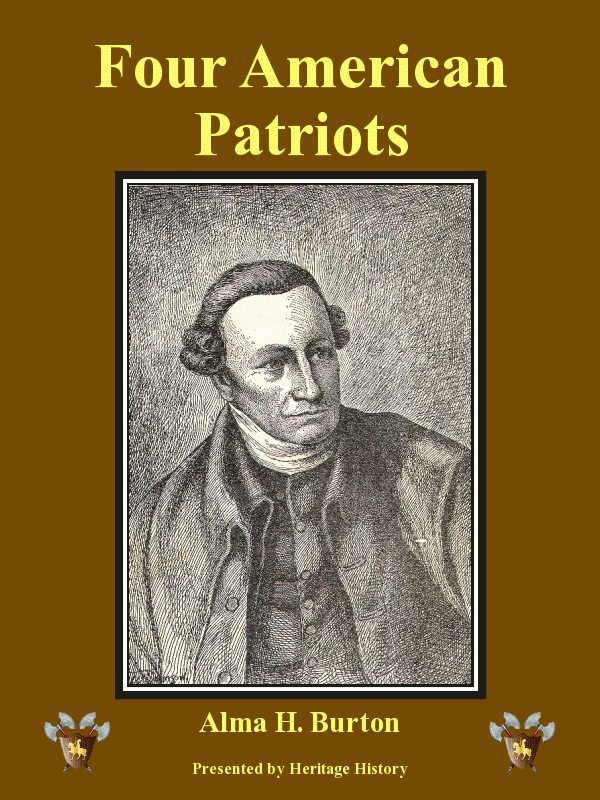 |
Four American Patriots by Alma Holman Burton
Stories of four famous Americans. These well-developed biographies include the stories
of Patrick Henry, the first governor of Virginia; Alexander Hamilton, the first Secretary
of the Treasury; Andrew Jackson, Indian fighter and seventh president; and Ulysses S.
Grant, Civil War Hero and eighteenth president.
[81 sheets]
|
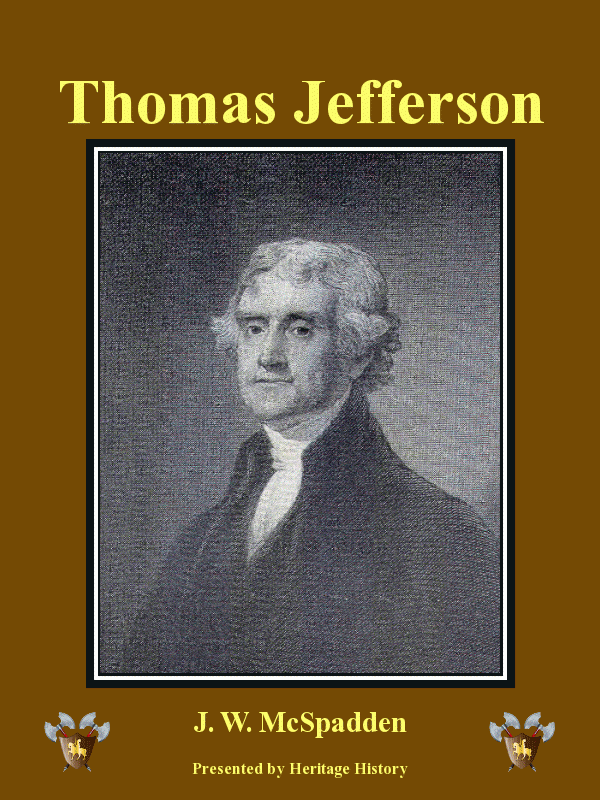 |
Thomas Jefferson by J. Walker McSpadden
Short biography of Thomas Jefferson which follows his career from a young law student,
to that of President of the United States. He composed the declaration of Independence
while still a young man, and did not become president until a quarter century afterward.
Until that time he worked for the government of Virginia and spent many years as the
American ambassador to France.
[56 sheets]
|
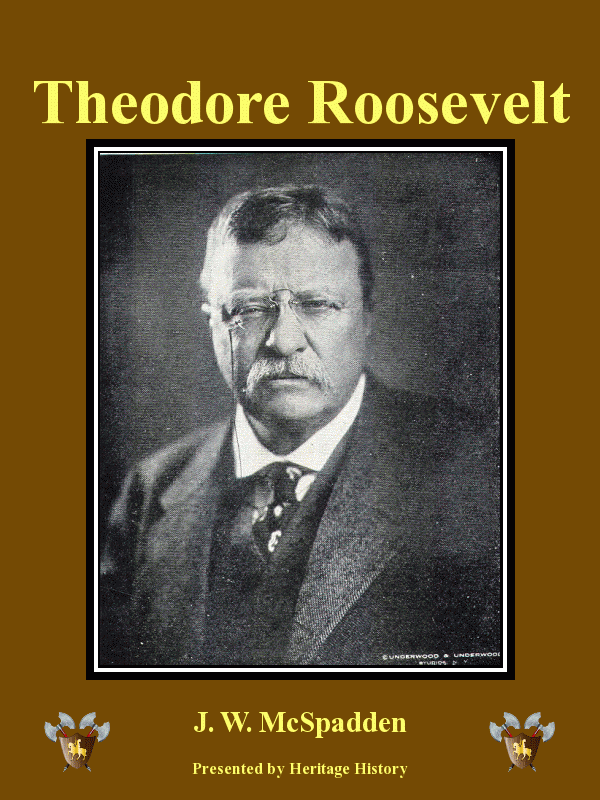 |
Theodore Roosevelt by J. Walker McSpadden
Short biography of Teddy Roosevelt, the 26th president of the United States. Describes
his early years as he developed from a sickly child, to an advocate of the 'strenuous
life'. His years spent studying in the east were followed by those of sport, exercise
and work in the far west. His rise to national fame came quickly, particularly after his
famous Charge with the Rough Riders at San Juan Hill. As a president he was an
uncompromising reformer, who gathered both a large following, and many enemies. He remains
one of the most colorful of American presidents.
[60 sheets]
|
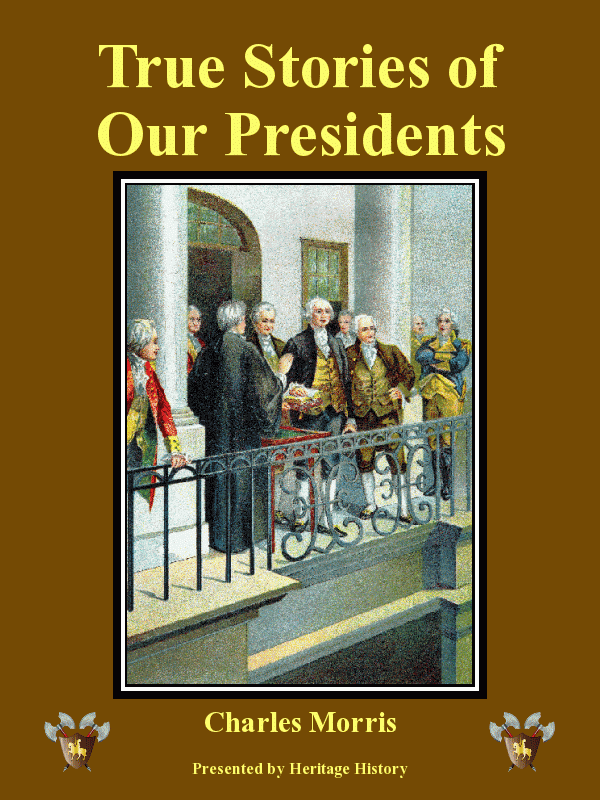 |
True Stories of Our Presidents by Charles Morris
Charles Morris provides fascinating sketches of the first twenty-three presidents. The
life stories of some, such as Washington and Lincoln, are already well known, but many of
our lesser known Presidents had fascinating lives prior to becoming president, and these
are told with great interest in this volume. The book does not focus on issues or
political achievements of the presidents while they were in office, but rather, on their
character and career before being elected to the highest office in the land.
[124 sheets]
|
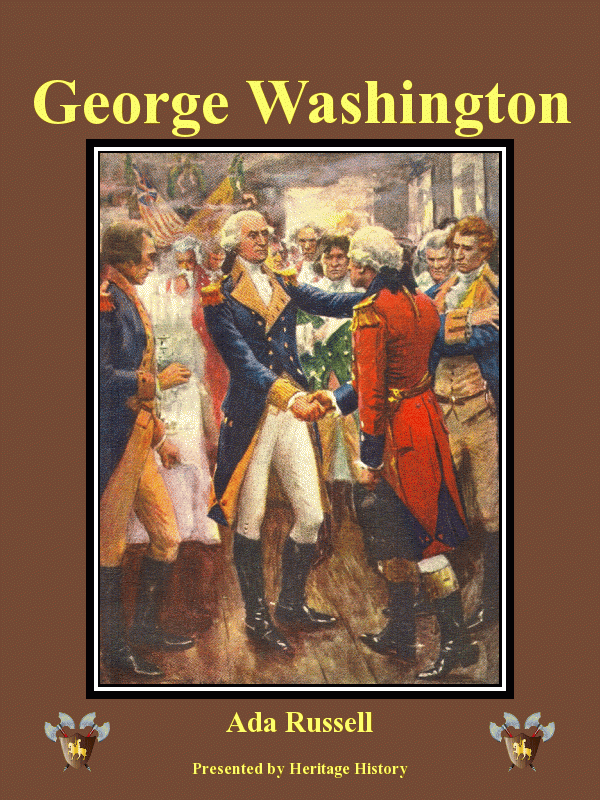 |
George Washington by Ada Russell
This middle school biography of Washington tells the story of his youth, young
adulthood, and career as commander of the Revolutionary forces. The final chapter
summarizes his accomplishments as first President of the United States, and the appendix
includes a selection of Journals, letters, and addresses given by the foremost of the
founding fathers that make for fascinating reading and give first hand insight into his
character.
[81 sheets]
|
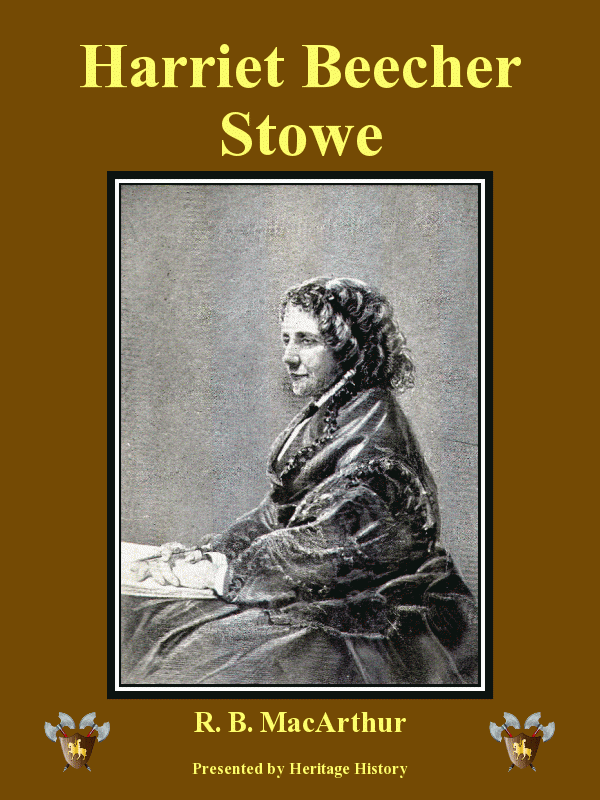 |
Harriet Beecher Stowe by Ruth Brown MacArthur
This short biography tells the life of Harriet Beecher Stowe, the daughter of a New
England abolitionist who wrote the landmark novel Uncle Tom's Cabin which did much
to incite American sympathy for Negroes toiling under the slavery in the south. It shows
how her life as daughter and sister of Protestant preachers, and work with her
abolitionist husband on the Underground Railroad contributed insights into her views on
slavery.
[53 sheets]
|
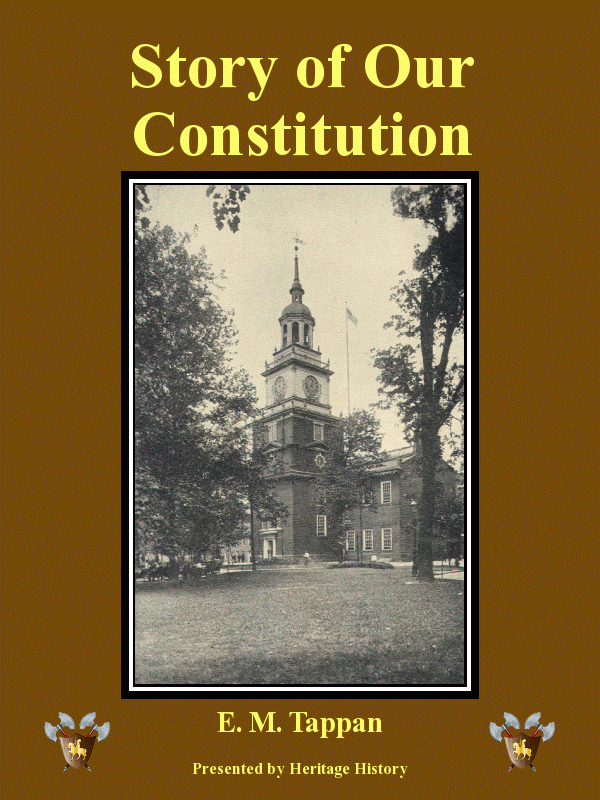 |
The Story of Our Constitution by Eva March Tappan
This books combines both history and civics, as it pertains to the founding documents of
the United States of America. It explains the state of the Confederation following the
civil war and the persons and events which drove the development of the American
Constitution. Included are stories of the circumstances which led to the passage of the
first through 19th amendments.
[54 sheets]
|
Explorers and Inventors
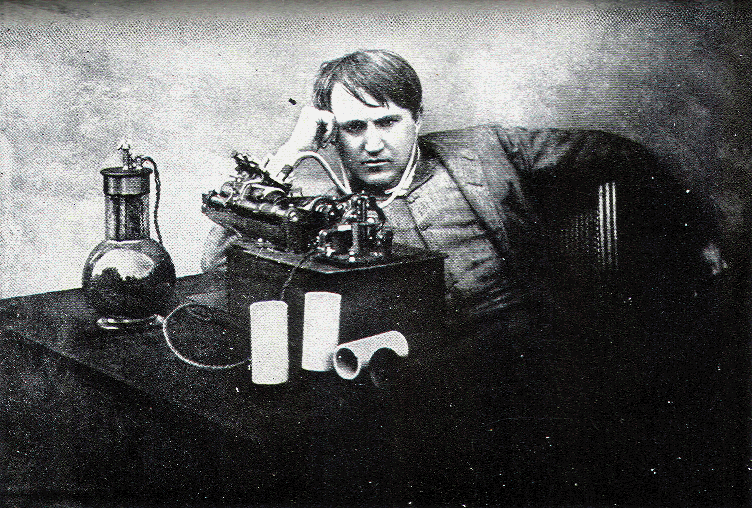
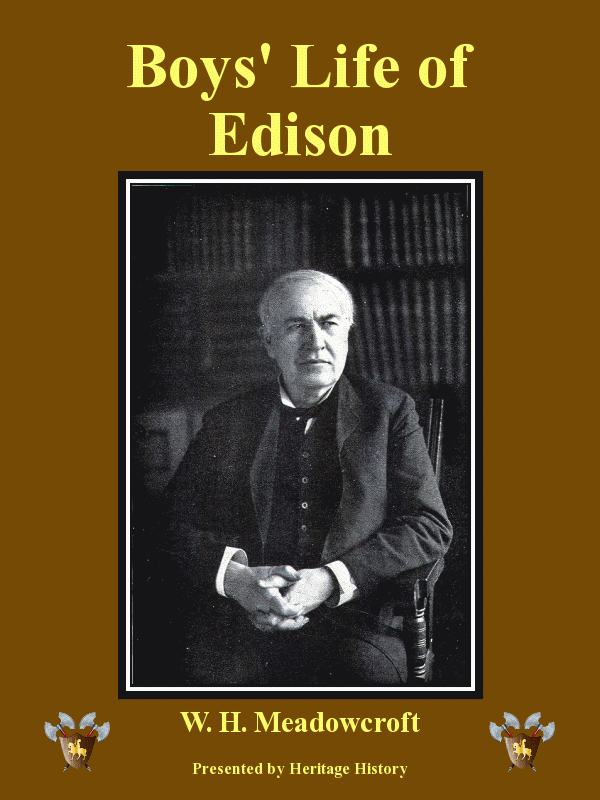 |
Boys' Life of Edison by William H. Meadowcroft
This biography of Thomas Edison was written by a close associate and contains many
autobiographical anecdotes. Much attention is given to Edison's early life and the author
paints a picture of a young man whose resourcefulness and entrepreneurial tendencies were
apparent from a young age. The range of Edison's contributions to American industry is
simply astounding, and his entire life is rich in relevance, but is also rich in anecdote
and humor since Edison's ceaseless activities led to innumerable conflicts and adventures.
[98 sheets]
|
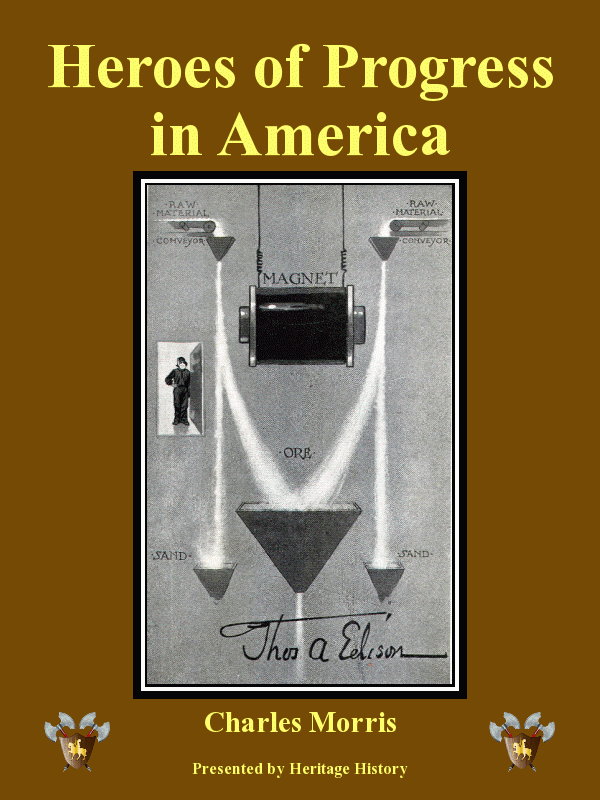 |
Heroes of Progress in America by Charles Morris
This collection of American biographies tells the stories of four dozen heroes,
including statesmen, patriots, inventors, religious leaders, suffragettes, businessmen,
and philanthropists. About half of the subjects are quite famous but many others, such as
Robert Morris, George Peabody, and Peter Cooper, contributed greatly to America life but
are not as well known.
[151 sheets]
|
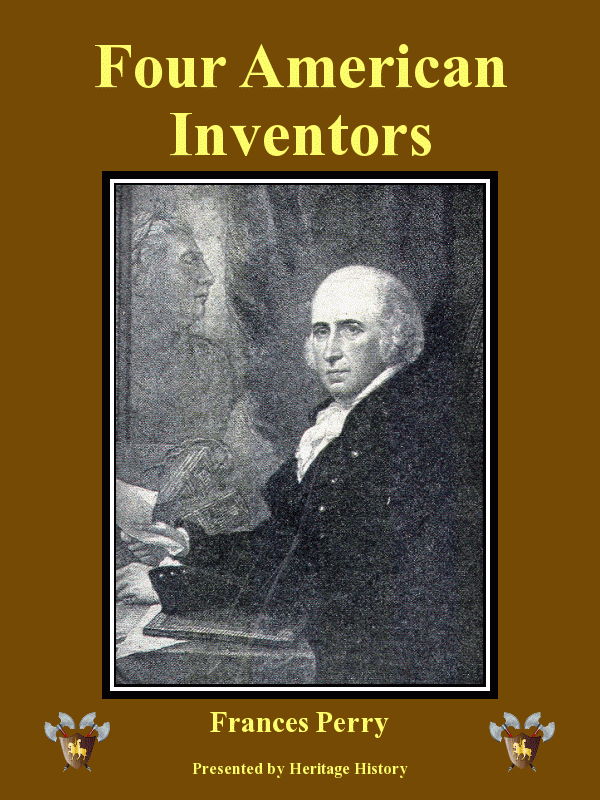 |
Four American Inventors by Frances M. Perry
Four short biographies of some of the most important inventors in American history, are
provided in a single volume. The subjects include Fulton (steam-boat), Whitney
(cotton-gin), Morse (telegraph), and Edison (all sorts of stuff). Attention is given not
only to the lives of the subjects, but also to the importance of their inventions in
American history.
[83 sheets]
|
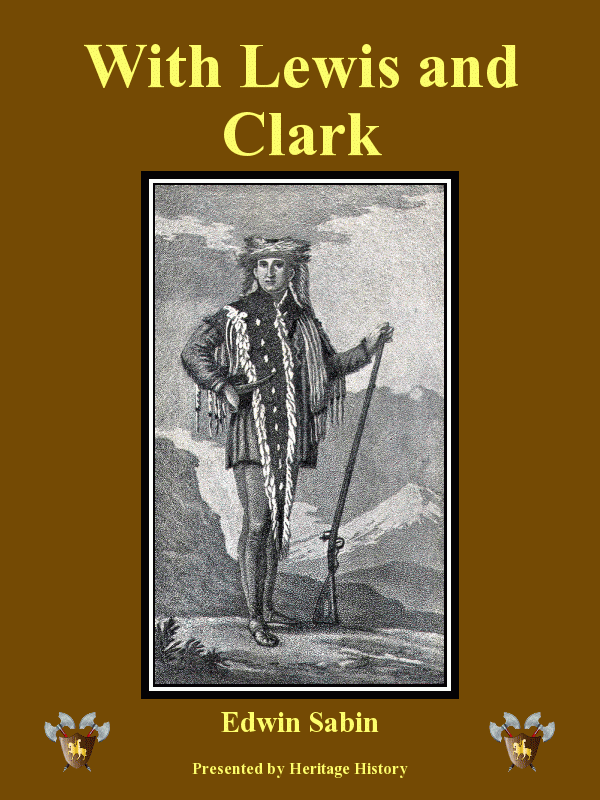 |
Opening the West With Lewis and Clark by Edwin Sabin
The primary character in this story is a pioneer boy who tags along with the Lewis and
Clark expedition. The main character was raised by Indians after his family is killed and
so is able to help the party as a translator. He describes the characters, sites and
events of the expedition with great detail and interest. Although the story is fictional
it is based on meticulous research and presents many true-to-life incidents associated
with the famous expedition.
[114 sheets]
|
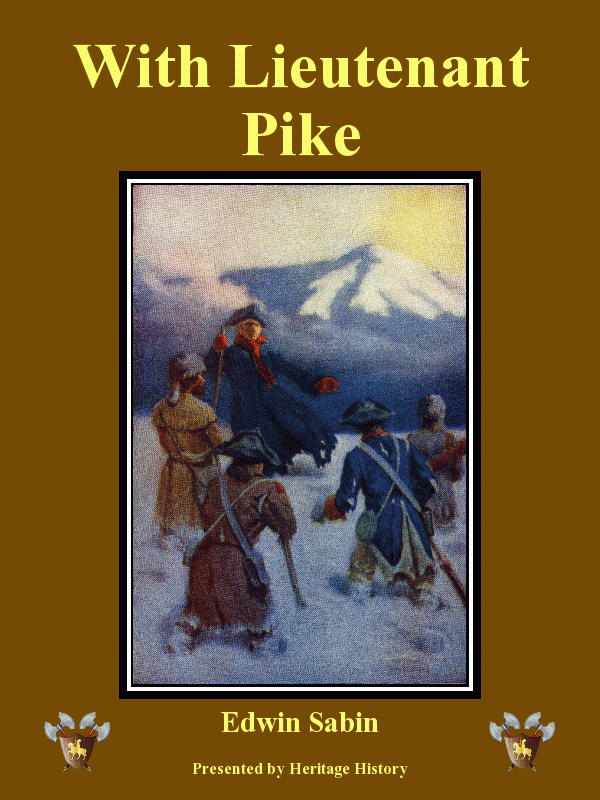 |
With Lieutenant Pike by Edwin Sabin
This book tells the story of a boy, kidnapped by Indians as a youth, who joins the
expedition of Lieutenant Pike as he travels down the Arkansas river towards the rocky
mountains. During the expedition they travel to Colorado and discovered Pike's peak before
becoming lost, and ending up in Spanish territory. Although the main character is
fictional, most of the events depicted in the story are faithful to the real history of
the Pike expedition.
[114 sheets]
|
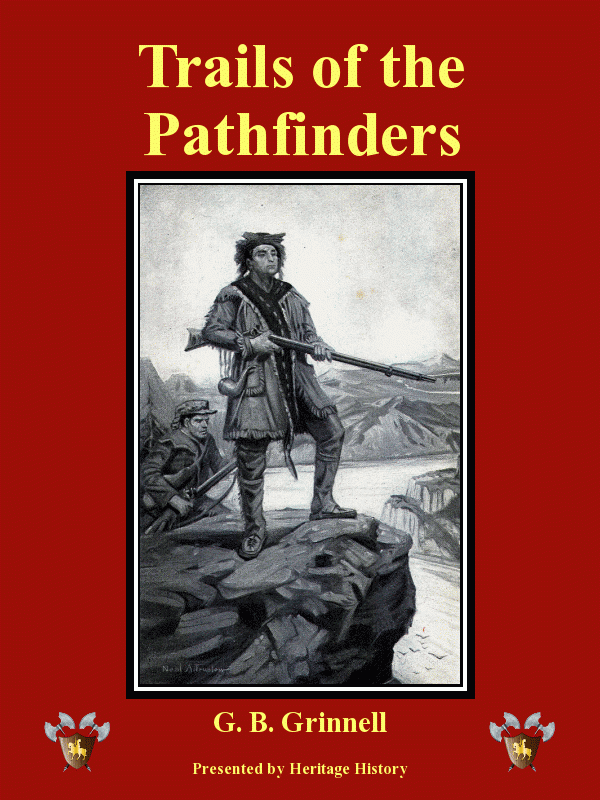 |
Trails of the Pathfinders by George Bird Grinnell
This book focuses on the stories of the earliest English Speaking explorers of the
American wilderness, several of who pre-dated Lewis and Clark. Using original journals as
sources, these stories tell of traders, trappers and others who traveled into Indian
territory when it was still wild, and paved the way for later settlers. The expeditions
recounted in this book range from those of Alexander Henry in the 1770's, to Fremont's
journey to California in the 1840's.
[171 sheets]
|
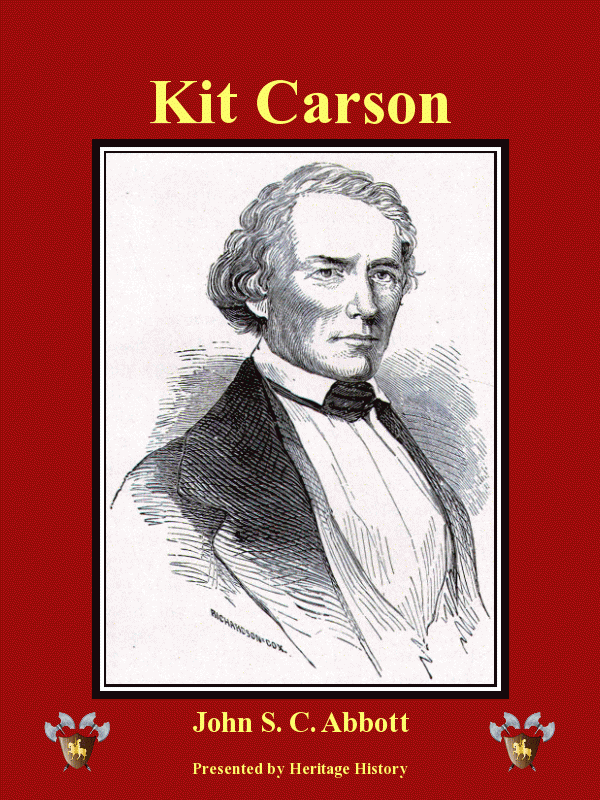 |
Kit Carson by John S. C. Abbott
This book tells the life story of Kit Carson one of the most famous and frontiersmen of
the American southwest. It follows his exploits guiding the Fremont expedition and his
relationship with many of the native tribes of the region. Carson's contributions to
settlement of the New Mexico, Arizona, and California throughout his 25 year career were
enormous, and he was admired by both white men and Indians for his gentlemanly character
in a lawless age.
[160 sheets]
|
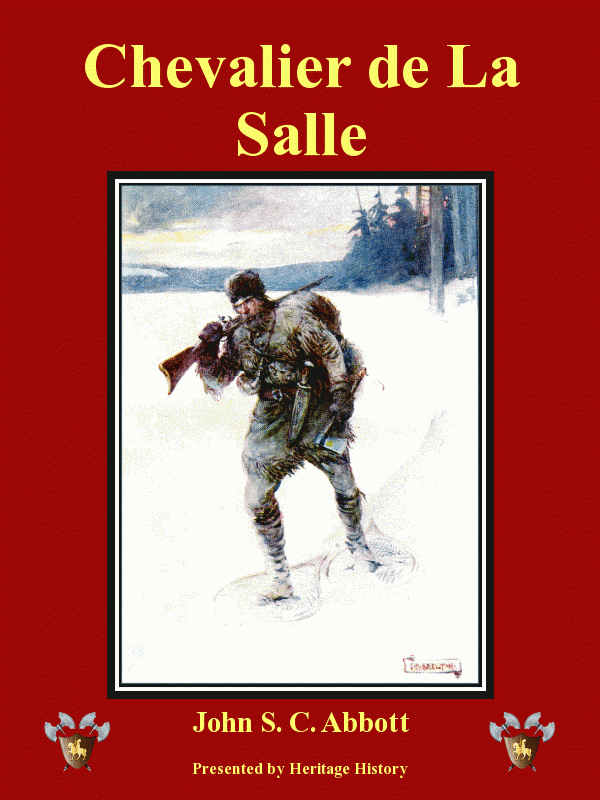 |
Chevalier de La Salle by John S. C. Abbott
La Salle was a French explorer who followed the path of the Mississippi river from the
great lakes to the Gulf of Mexico. In doing so he overcame nearly insurmountable
difficulties and faced down terror, privation, freezing cold, and savage natives. He
passed thousands of miles of lakes and rivers in a birch canoe and transversed countless
trails to claim the Mississippi valley for France.
[81 sheets]
|
American Indian History
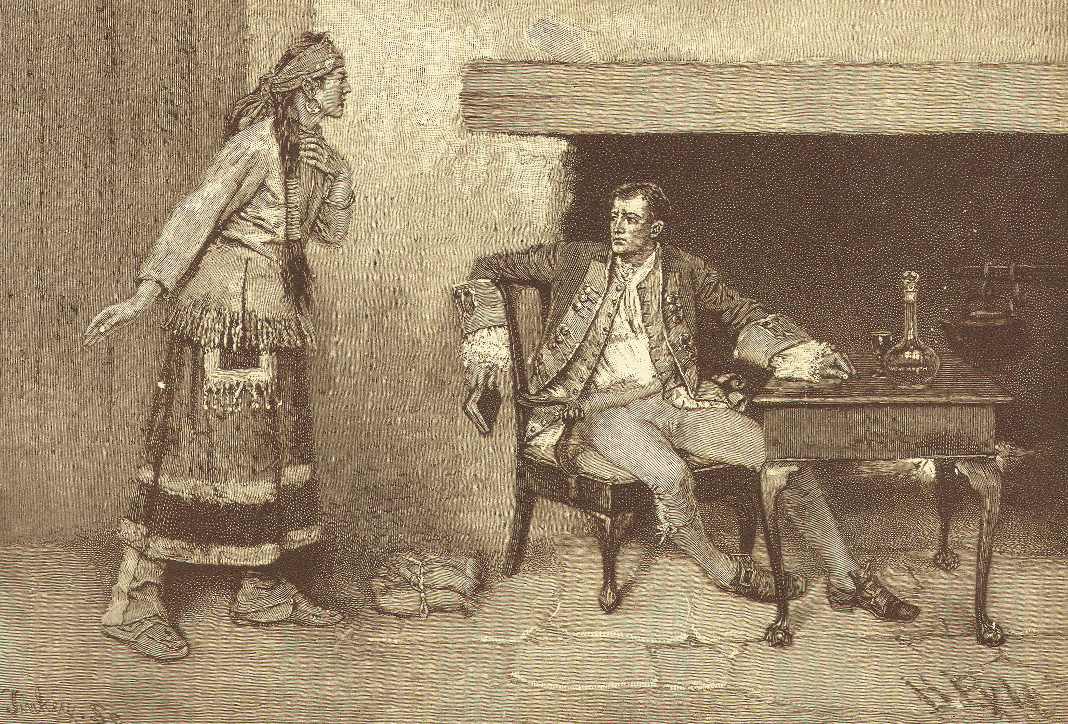
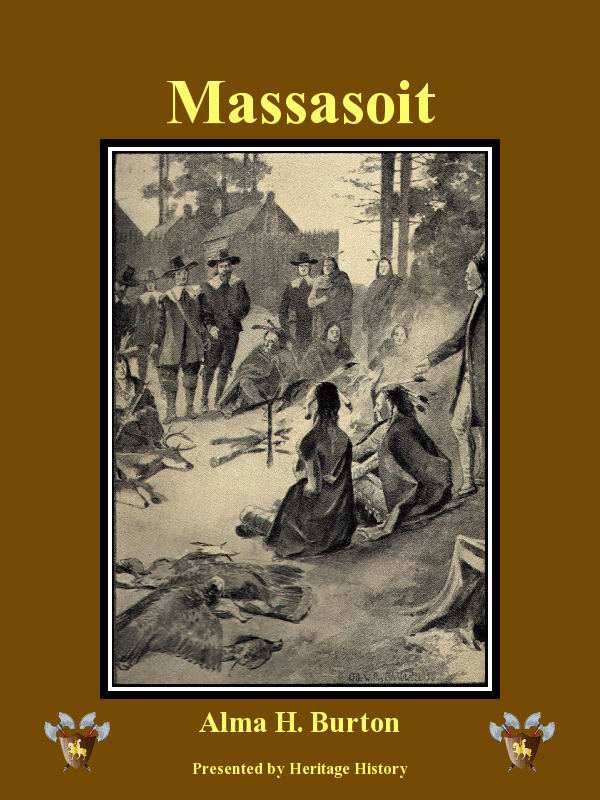 |
Massasoit by Alma Holman Burton
The story of the Wampanoag Indians and their dealing with the Indians is told in a
manner appropriate for young readers in this charming but tragic book. Massasoit was the
Great Sachem of the New England tribe that was most helpful and friendly to the Pilgrims
in the early years. Within his lifetime however, the number of white men in the area
constantly increased and by the time his son, King Philip, came to rule the tribe,
conflict between the settlers and the native Indians was inevitable.
[98 sheets]
|
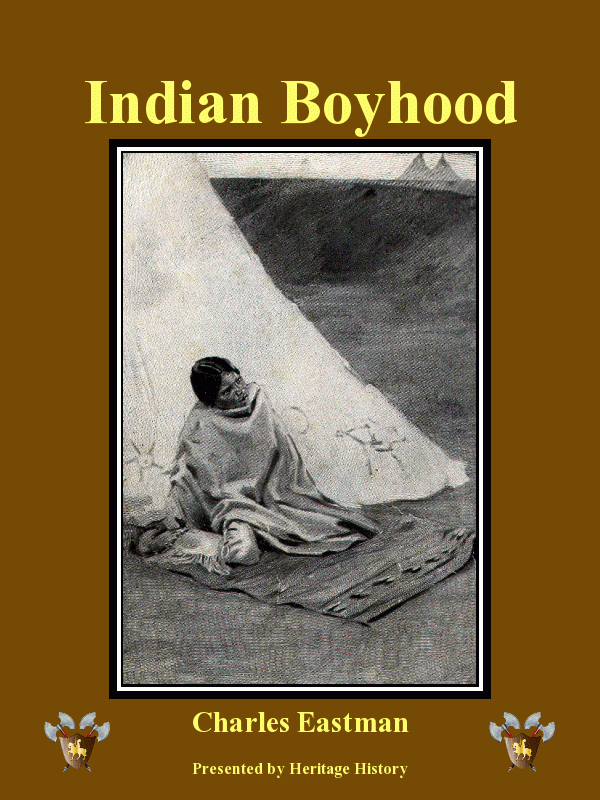 |
Indian Boyhood by Charles A. Eastman
Autobiographical story of a the last few years of childhood for a plains Indian boy
whose family converts to Christianity and sends him to school in "civilization." He
adjusts well to his new life but remembers his free and easy early years with great
fondness. The author wrote many books on Indian life and was involved in the formation of
the American Boy Scouts.
[90 sheets]
|
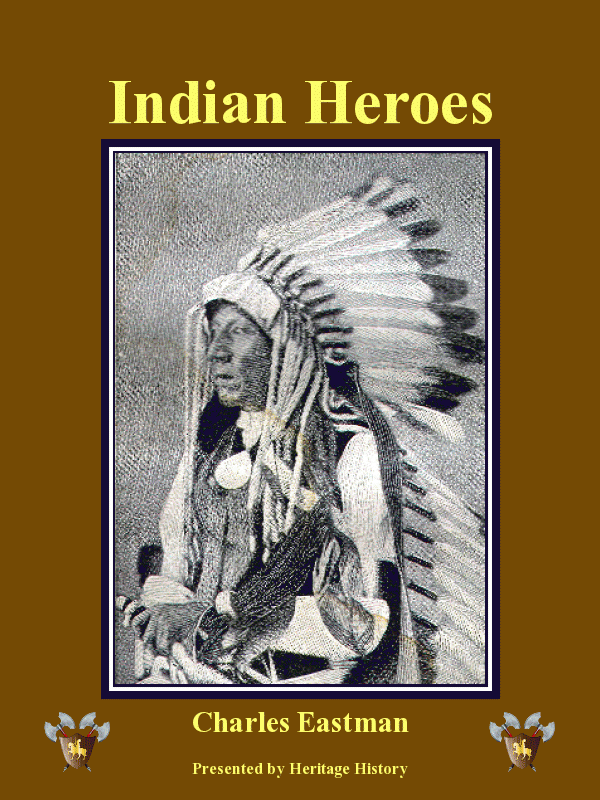 |
Indian Heroes by Charles A. Eastman
This book gives an insightful account of many of the most important chiefs of the Plains
and Northwest Indians. Besides the very well-known Indian heroes such as Red Cloud,
Sitting Bull, and Chief Joseph, it also gives the stories of several lesser known Sioux
and Dakota chiefs such as Spotted-Tail, Dull Knife, and Rain-in-the-face.
[62 sheets]
|
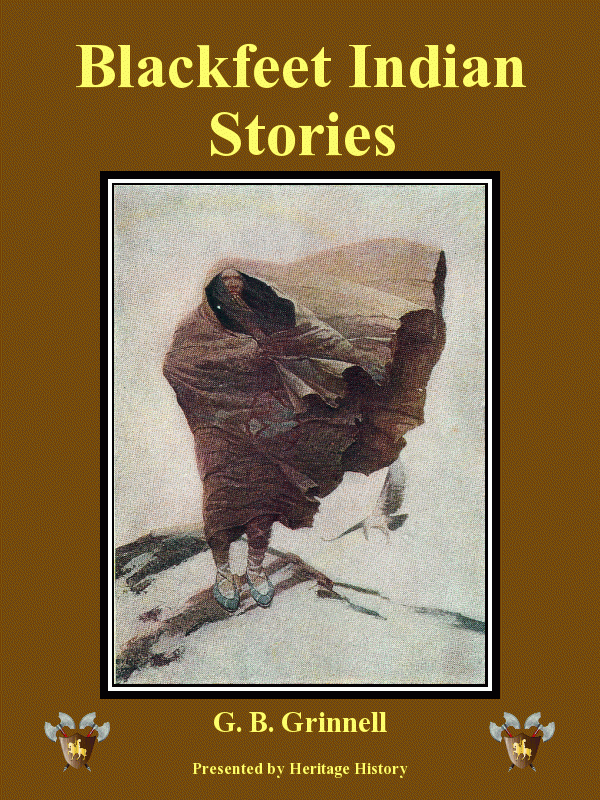 |
Black feet Indian Stories by George Bird Grinnell
This collection of Blackfeet legends and stories was written by George Bird Grinnell,
one of the foremost Indian scholars of the day, and an early naturalist. It includes
nature and creation legends and hero tales, as well as humorous stories. The final chapter
provides much information about Blackfeet life and culture.
[62 sheets]
|
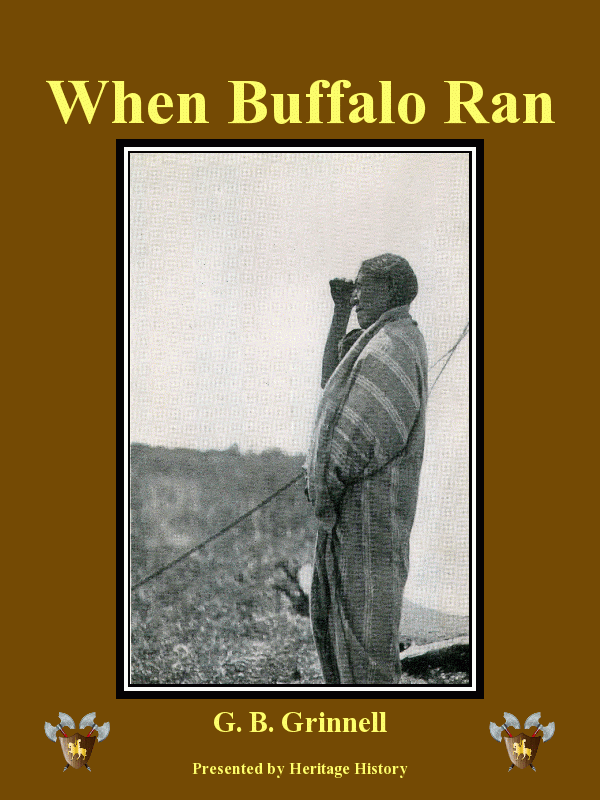 |
When Buffalo Ran by George Bird Grinnell
This book recounts the true story of a boy growing up among the plains Indians in the
early nineteenth century during the years when the white men were steadily encroaching
upon the Indian territories and threatening their way of life. It was written by one of
the predominant scholars of Indian history of the early 20th century.
[41 sheets]
|
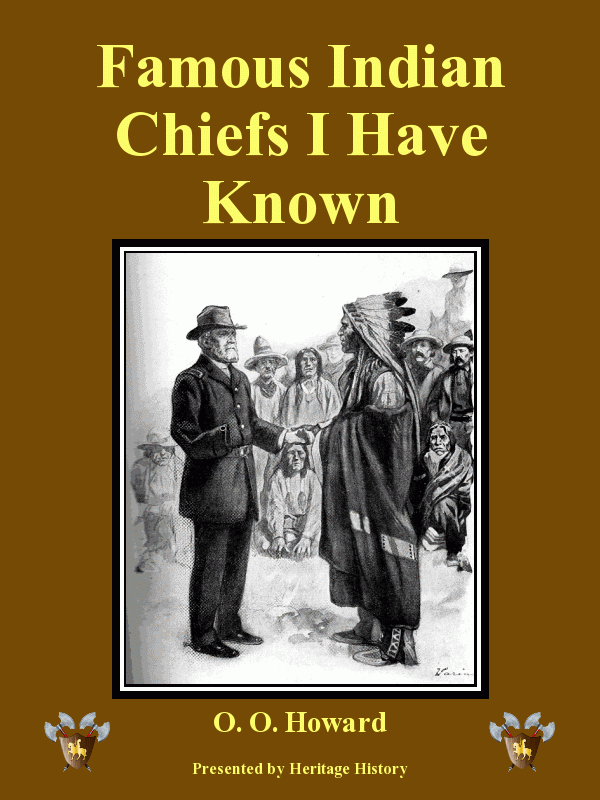 |
Famous Indian Chiefs I Have Known by Oliver Otis Howard
The author of this book was a famous Civil War General, head of the Freedman's Bureau
and founder of Howard University. As liaison for Indian Affairs under President Grant, he
negotiated with almost all the major Indian Chiefs in the west in the decades after the
civil war. He was sympathetic to their plight and tried to arrange peace between the white
men and Indians.
[80 sheets]
|
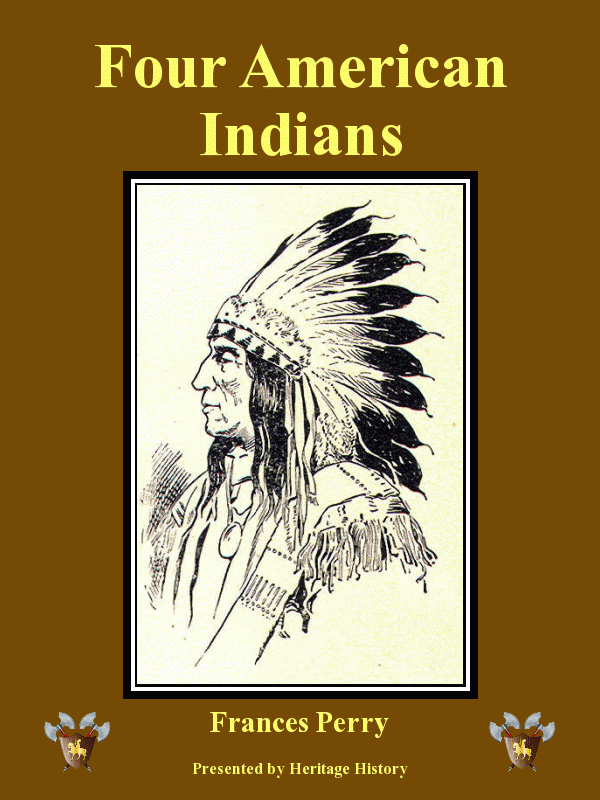 |
Four American Indians by Frances M. Perry
Short and sympathetic biographies of four of the most prominent Indian chiefs in
American History are provided in a single text. Each of the four subjects, including King
Philip, Pontiac, Tecumseh, and Osceola, were talented leaders who organized diverse tribes
to fight against the encroachments of the white man.
[98 sheets]
|
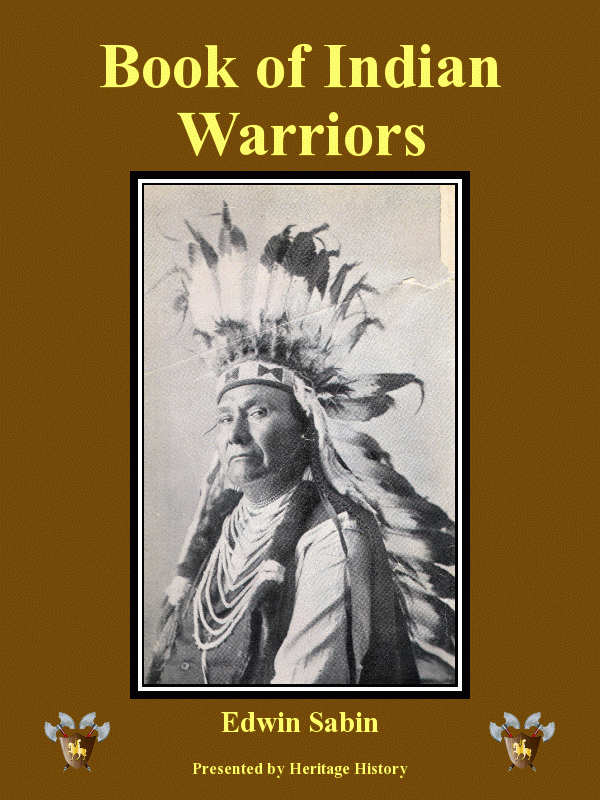 |
Boys' Book of Indian Warriors
by Edwin Sabin
This book, written from the point of view of the American Indians who tried to defend
their land from the white men, highlights the lives and deeds of some of the most
important Indian chiefs from the earliest Iroquois and Algonquins in 17th century New
England, to the flight of the Nez Perces under Chief Joseph. Piskaret, King Philip,
Pontiac, Logan and Cornstalk, Little Turtle, Tecumseh, Black-hawk, Red Cloud, and Sitting
Bull are some of the Chiefs whose stories are told here.
[147 sheets]
|
 |
With the Indians in the
Rockies by James W. Schultz
This book tells the fascinating story of two young men, one Indian and one white, who
became stranded in the Rockies in early winter with only the clothes on their back.
Resorting to primitive methods of making fire, weapons, shelter and clothes, they survive
a frigid winter, and have numerous fantastic adventures. Although the book is fiction,
it is based on a story told by a well-known fur trader who had lived most of his life
among the Western Indians.
[63 sheets]
|
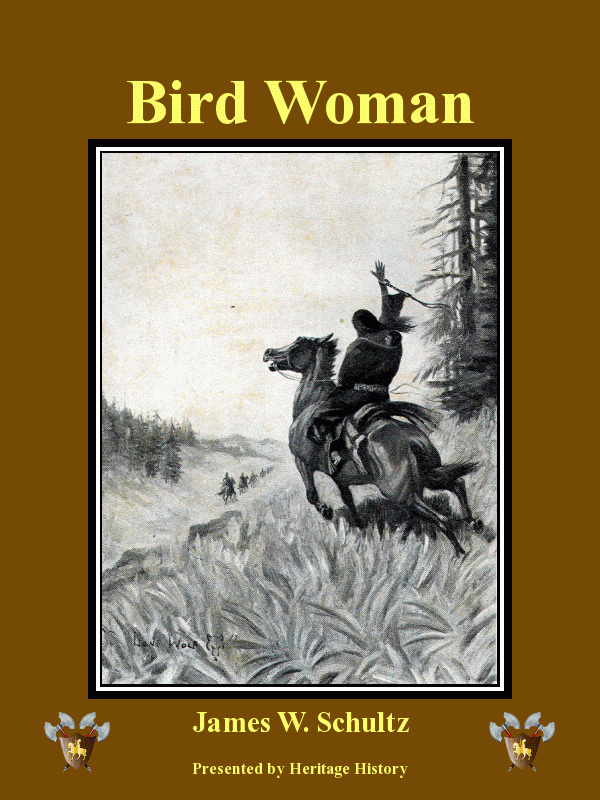 |
Bird Woman - Sacajawea by James W. Schultz
This moving account of the life of Sacajawea is recounted as told to some of the Sioux
Indians and frontiersmen who actually met her and other members of the Lewis and Clark
expedition. They tell, not only of her heroism during the great expedition, but of her
early life, and the story of her capture by hostile Indians which ended in her marriage to
a French trader. The author was a trader who lived much of his life among the Indians of
Montana and knew members of Sacajawea's tribe personally .
[76 sheets]
|
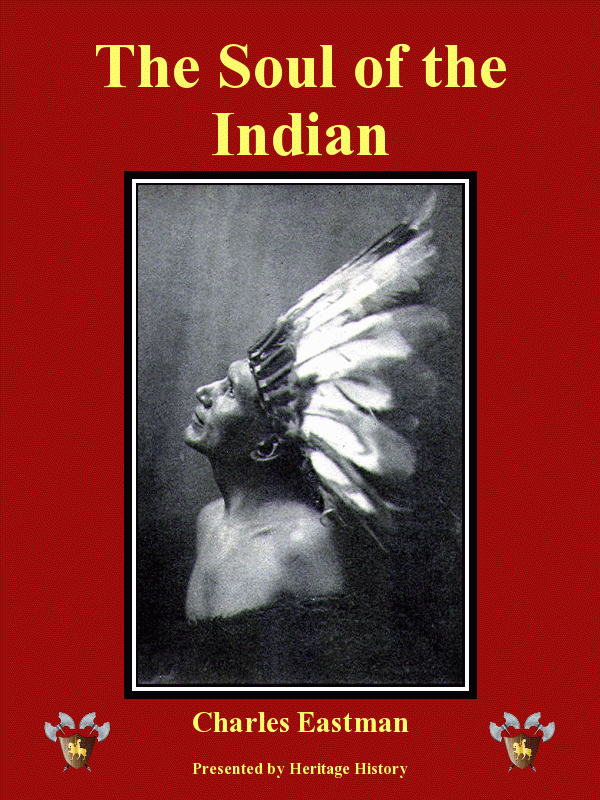 |
The Soul of the Indian by Charles A. Eastman
An accessible and thoughtful discourse about the native religion of the American Indians,
written by a Dakota Indian. He treats issues of worship, morals, and afterlife
sympathetically and with great insight into the Indian soul.
[29 sheets]
|
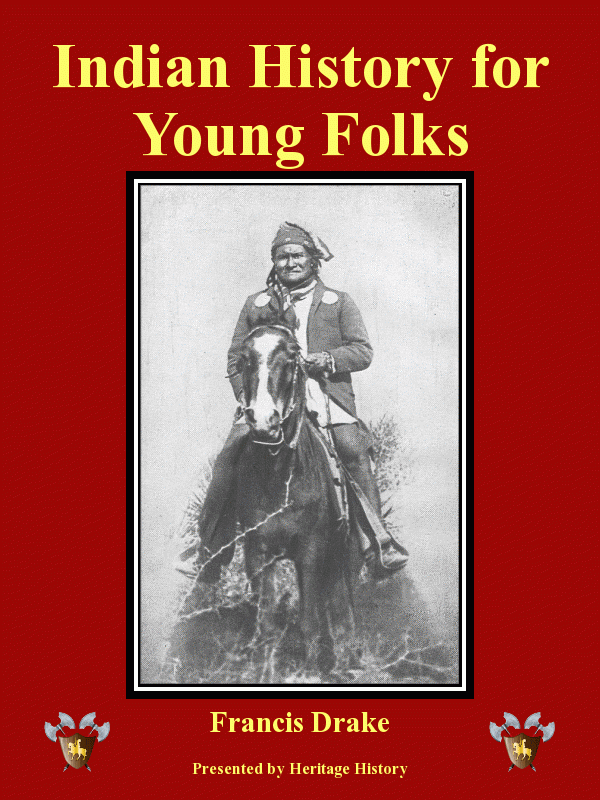 |
Indian History for Young Folks by Francis S. Drake
This book was considered the standard narrative of the history of the American Indians
from the time its first version was published in the 1880's to the mid twentieth century.
It was written for the general reader and is both thorough and well balanced. It gives
fair treatment to the point of view of the Indians and early white settler, and dozens of
anecdotes illustrate both the treachery and misdealing as well as faithful friendships
between the two civilizations.
[284 sheets]
|
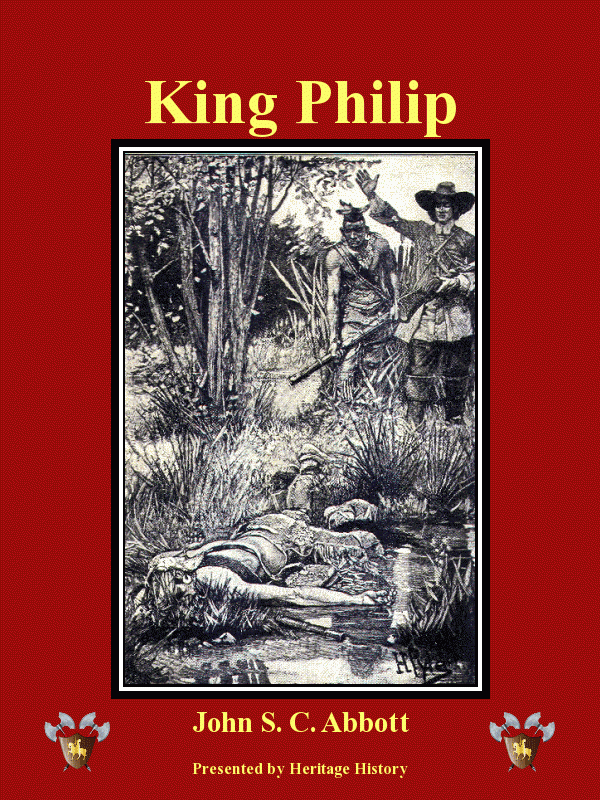 |
King Philip by John S. C. Abbott
King Philip was the leader of the Wampanoag Indians. His father Massasoit had been
friendly to the early American colonists in New England. After a long period of peace, he
saw that as the colony thrived, his lands were ever diminished. He realized the Indians
were doomed unless they drove the white men from their soil, and so turned against the
settlers in what became the most ferocious uprising of Indians in New England history.
[118 sheets]
|
American Negro History
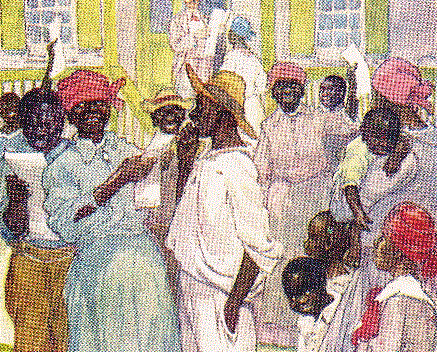
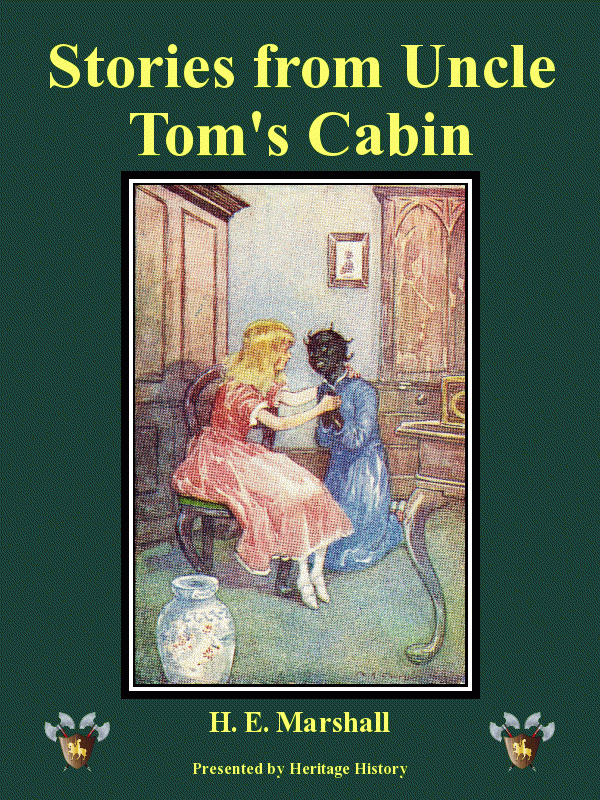 |
Uncle Tom's Cabin
by H. E. Marshall
This short retelling of Harriet Beecher Stowe's Uncle Tom's Cabin tells the life
stories of a number of slaves and slave-owners in the south, and shows the detrimental
effects of servitude on both master and slave. It follows the original story faithfully
and does an excellent job of depicting complex character development in a brief space.
[48 sheets]
|
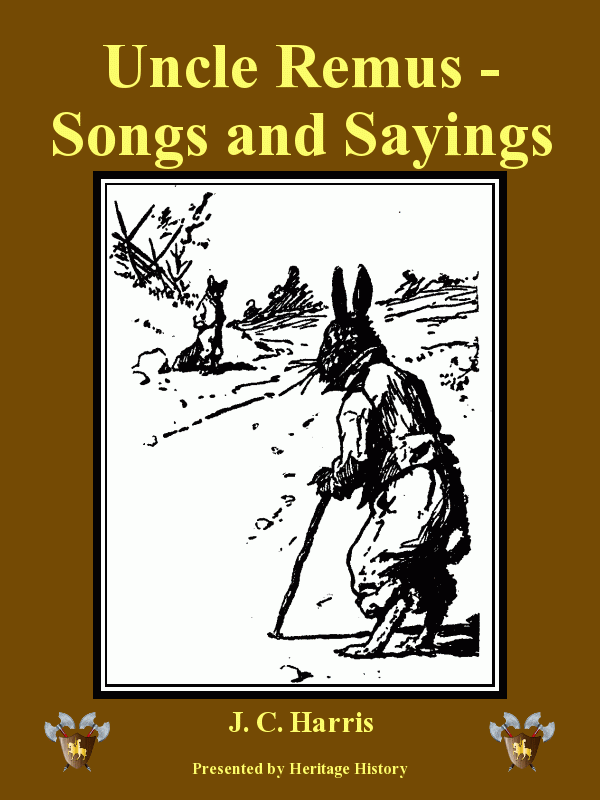 |
Uncle Remus - Songs and Sayings by Joel Chandler Harris
This delightful and very funny book recounts stories told by a former slave, Uncle
Remus, to children of the south in the days after the Civil war. Most of the stories
involve mischievous animals and they are told with terrific flair and humor. Much of the
book is written in a negro dialect that may be difficult for inexperience readers, but is
delightful when read aloud.
[125 sheets]
|
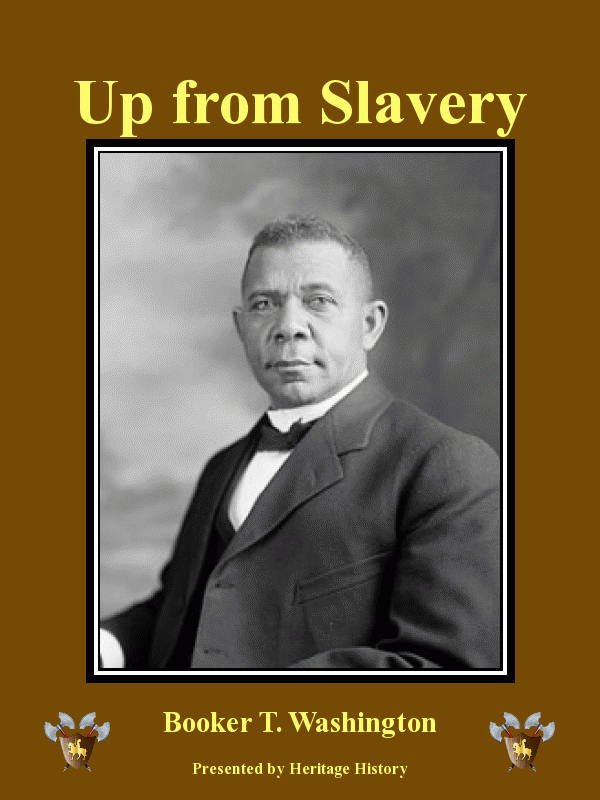 |
Up from Slavery by Booker T. Washington
Autobiography of Booker T. Washington, a man who was born into slavery, but overcame
hardships through hard work and diligence. At 25, he became the first principle of
Tuskagee college, founded to teach newly freed slaves the skills to gain employment. In
this position he rose to become a nationally known figure, and advocate for American
freedmen. His story provides great insight into the condition of the former slaves of
the south in the years following the civil war.
[113 sheets]
|
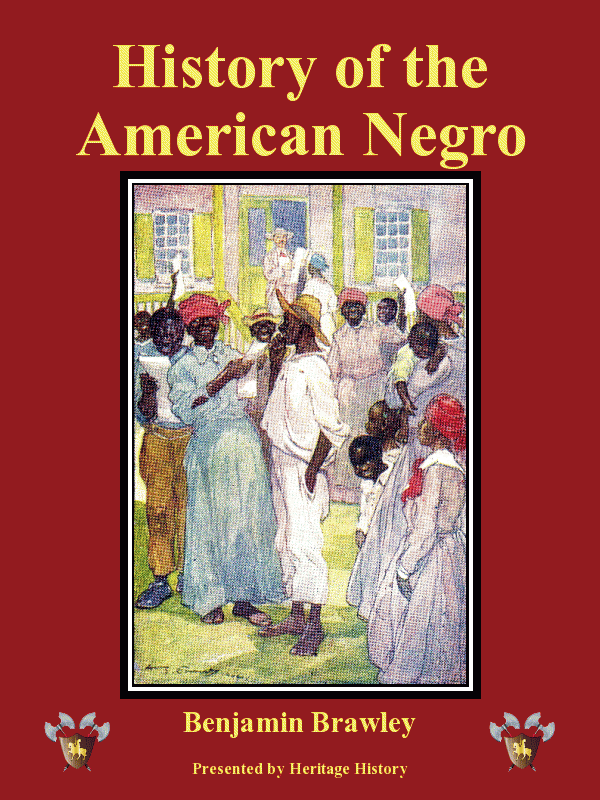 |
History of the American Negro by Benjamin Brawley
This book, written by a dean of Morehouse College, provides a brief history of negroes
in America beginning with the first incidences of slavery in the American colonies and
ending with an analysis of the state of the American negro in the early 20th century. The
stories of several important negro leaders are given, and the politics of slavery,
emancipation, and reconstruction efforts in the south are discussed.
[90 sheets]
|
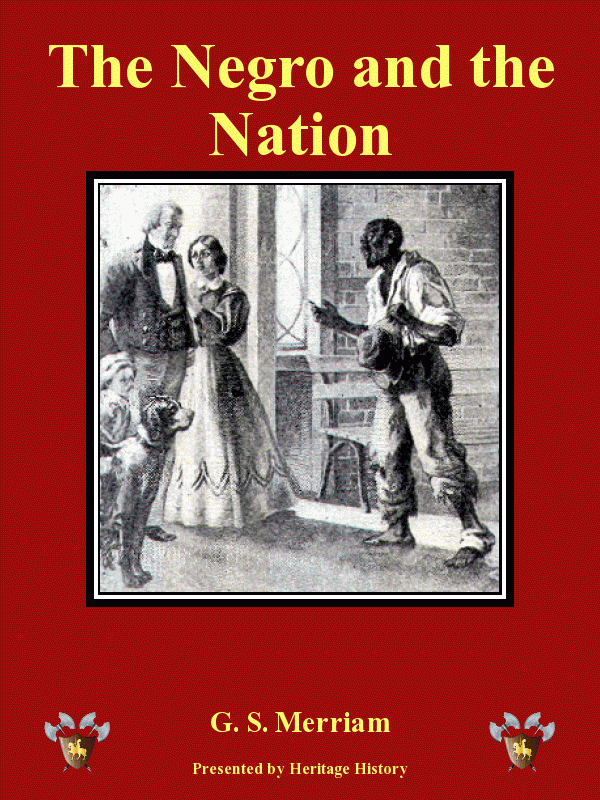 |
Negro and the Nation by George S. Merriam
This book provides a comprehensive overview of the state of American Negros in the years
before and after their emancipation. The severe political conflicts in the years leading
up to the Civil War and during the reconstruction period afterward are explained
thoroughly, and several short biographies of important negro political leaders are given.
[188 sheets]
|
The number of sheets listed indicates the number of 8½ by 11 sheets of paper
required to print the
entire book, single-sided. Double-sided printing would allow publishing the entire book
using only half the
given number.
Copyright © Heritage History 2012
All rights reserved
|












